This site is made possible by member support. ❤️
Big thanks to Arcustech for hosting the site and offering amazing tech support.
When you buy through links on kottke.org, I may earn an affiliate commission. Thanks for supporting the site!
kottke.org. home of fine hypertext products since 1998.
Entries for March 2021
How Do Algorithms Become Biased?
In the latest episode of the Vox series Glad You Asked, host Joss Fong looks at how racial and other kinds of bias are introduced into massive computer systems and algorithms, particularly those that work through machine learning, that we use every day.
Many of us assume that tech is neutral, and we have turned to tech as a way to root out racism, sexism, or other “isms” plaguing human decision-making. But as data-driven systems become a bigger and bigger part of our lives, we also notice more and more when they fail, and, more importantly, that they don’t fail on everyone equally. Glad You Asked host Joss Fong wants to know: Why do we think tech is neutral? How do algorithms become biased? And how can we fix these algorithms before they cause harm?
According to the National Labor Relations Board, “Amazon repeatedly violated the rights of employees who pushed for health and safety improvements during the coronavirus pandemic”. But the NLRB is powerless to do anything about it.
30 of the Best Book Covers of the Year (So Far). Some great design in here.
Can’t Get You Out of My Head: An Emotional History of the Modern World
Can’t Get You Out of My Head: An Emotional History of the Modern World is the latest world-explaining documentary series from television journalist Adam Curtis. It’s available in the UK on BBC’s iPlayer and, unofficially as a fan upload, on YouTube; I’ve embedded the trailer and the first part above.
But what exactly is it about you might wonder, even after watching the trailer. Reading Sam Knight’s January 2021 profile of Curtis in the New Yorker might help you there:
For more than thirty years, Curtis has made hallucinatory, daring attempts to explain modern mass predicaments, such as the origins of postwar individualism, wars in the Middle East, and our relationship to reality itself. He describes his films as a combination of two sometimes contradictory elements: a stream of unusual, evocative images from the past, richly scored with pop music, that are overlaid with his own, plainly delivered, often unverifiable analysis. He seeks to summon “the complexity of the world.”
Lucy Mangan’s review for The Guardian was overwhelmingly positive:
The power dynamic, how it shifts, how it hides and how it is used to shape our world — the world in which we ordinary people must live — is Curtis’s great interest. He ranges from the literal rewriting of history by Chairman Mao’s formidable fourth wife, Jiang Qing, during the Cultural Revolution to the psychologists plumbing the depths of “the self” and trying to impose behaviours on drugged and electro-shocked subjects. He moves from the infiltration of the Black Panthers by undercover officers inciting and facilitating more violence than the movement had ever planned or been able to carry out alone, to the death of paternalism in industry and its replacement by official legislation drafted by those with hidden and vested interests. The idea that we are indeed living, as posited by various figures in the author’s landscape and (we infer from the whole) the author himself, in a world made up of strata of artifice laid down by those more or less malevolently in charge becomes increasingly persuasive.
Other reviews, particularly from those on the right, call his work incoherent and Curtis himself something of a propagandist. Admission: I haven’t seen any of Curtis’s work, save for the occasional clip here and there. I know some of you out there are big fans — should I start with this one, HyperNormalisation, Century of the Self, or….?
Opening lines of books, rewritten for the pandemic. Jane Eyre by Charlotte Brontë: “There was no possibility of taking a walk that day. Too many people were outside without masks on. Oh, well, never too early for Netflix.”
You Don’t Know What’s Going On In People’s Lives
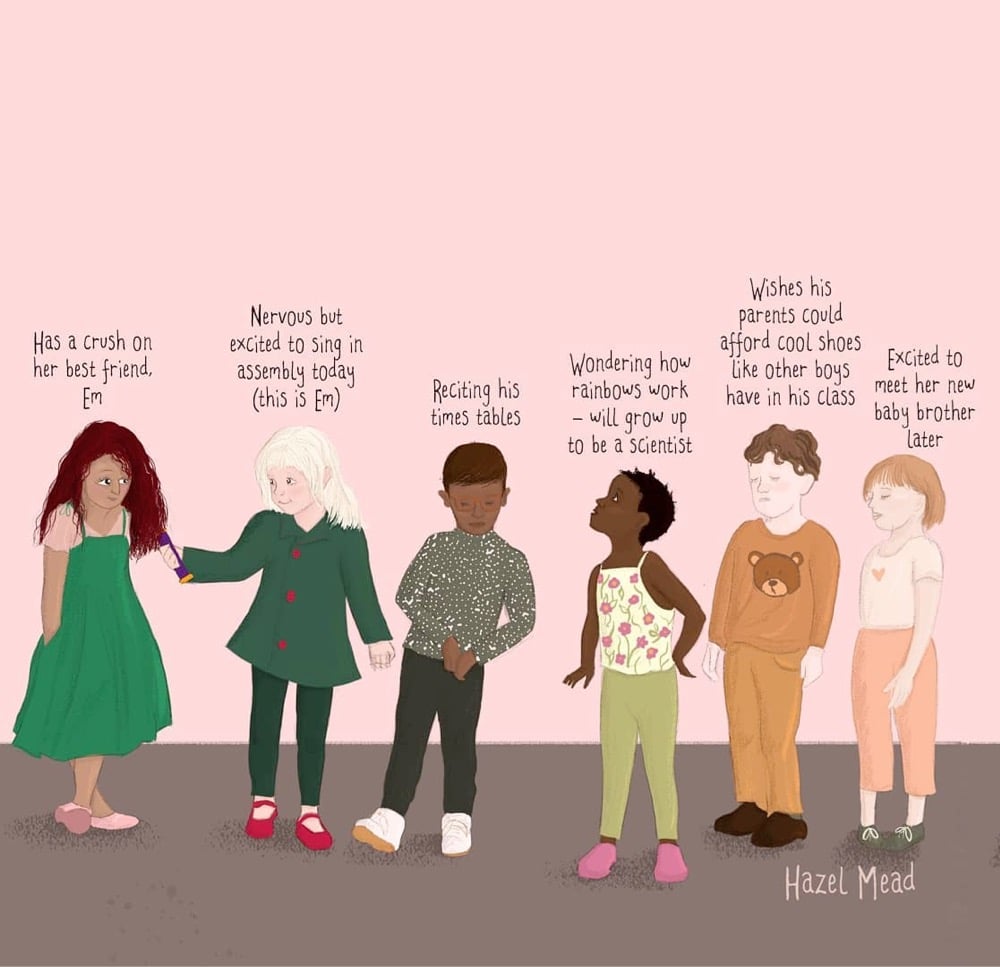
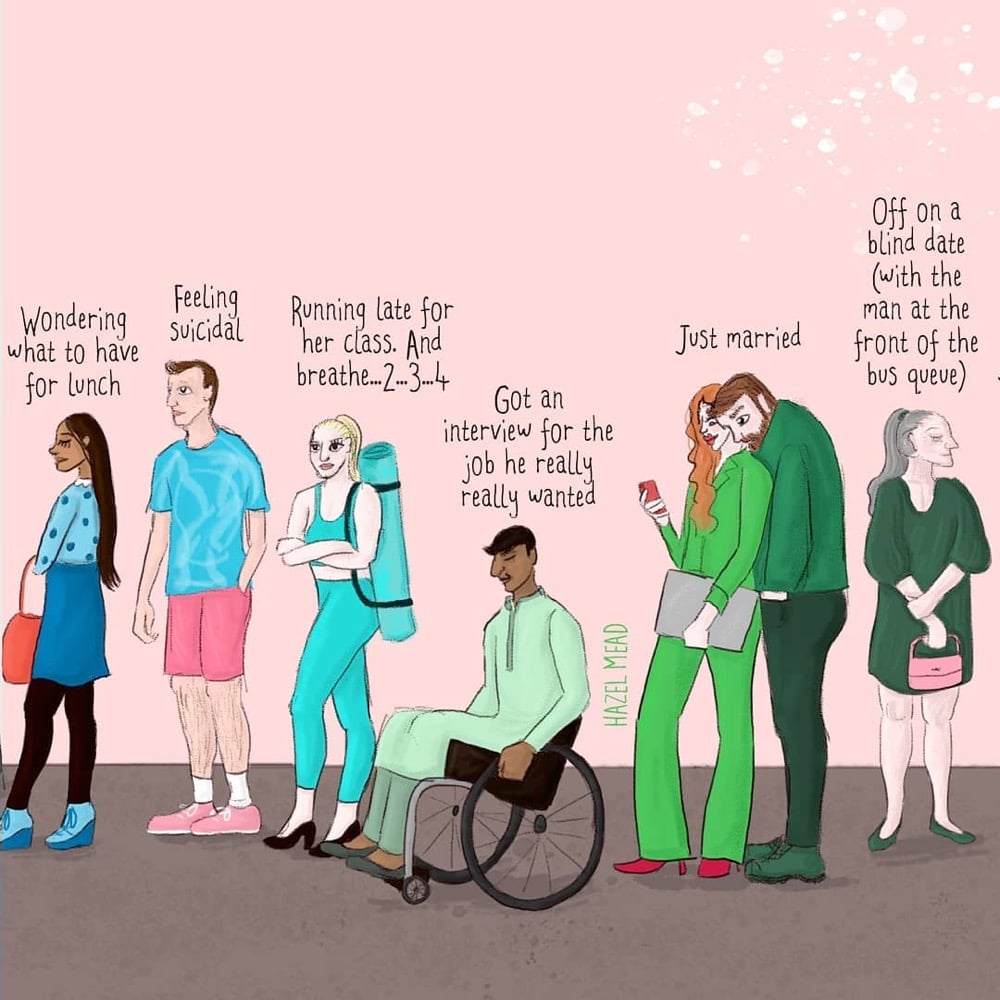
Illustrator Hazel Mead created a pair of pieces called You Don’t Know What’s Going On In People’s Lives: the original version and one featuring children. The images above are snippets from the larger images, both of which are available as prints in Mead’s shop. (via cup of jo)
Update: Several people sent me a link to this video from Cleveland Clinic that is very similar to Mead’s illustrations.
On the coming 4th surge of Covid-19 in the US. “I understand the impatience with restrictions – I’m fed up and tired, too – but our restlessness risks creating one last set of victims who could easily be spared.”
Delayed: R. Kikuo Johnson’s New Yorker Cover
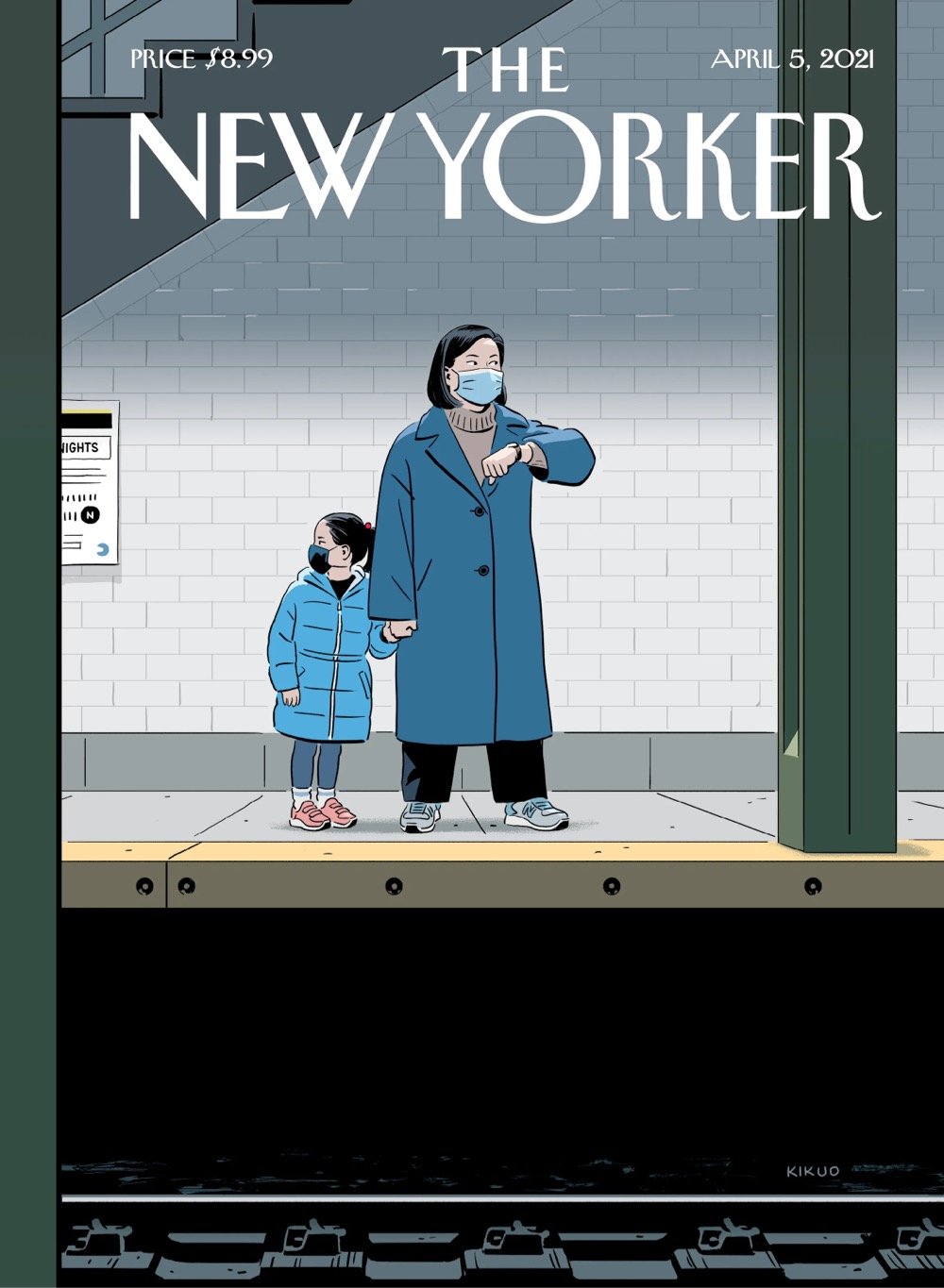
That’s the cover for the April 5, 2021 issue of the New Yorker illustrated by R. Kikuo Johnson.
I began preparing for this project by revisiting news coverage of anti-Asian hate crimes committed during the pandemic. As I absorbed one account after another, they became increasingly difficult to read. So many mothers and grandmothers have been targeted. I imagined my own mom in that situation. I thought about my grandma and my aunt, who have been among my greatest sources of support. The mother in the drawing is made up of all these women.
So simple, so powerful. The way the shoes, eyes, and faces are positioned and angled. On Twitter, Jiayang Fan commented:
I can’t stop staring at this cover. I can’t stop wondering who would come to this mother-daughter pair’s aid if someone attacked them. I can’t stop thinking I was once the daughter and how helpless I still feel to protect my mother.
“The Pfizer-BioNTech coronavirus vaccine is extremely effective in adolescents 12 to 15 years old, perhaps even more so than in adults, the companies reported on Wednesday.” Zero infections & no serious side effects in trials.
VW’s name change to “Voltswagen” is a dumb April Fools joke. Another own goal by the company. How about this: make good cars, sell them to people, and stfu.
Gradations Are Soothing
From Daihei Shibata, Gradations is a meditative short video of hard boundaries of color and shape turning into gradual transitions.
When we gradate the boundaries between two polarized things, the two become smoothly connected. By blurring the various boundaries, we can find complexity, diversity, and richness of information.
This is really lovely — take a couple minutes to watch. (via the equally lovely the kid should see this)
You can watch Bowling for Columbine for free on Michael Moore’s YouTube channel. I haven’t seen this in years – I wonder how it holds up?
Walking 56 Miles to Work
A few years ago, Beau Miles walked 56 miles to work on a college campus, leaving home with just the clothes on his back and a hat. He foraged what he needed along the way, including food, water, and a pair of shoes. Recently, he was asked to give a lecture on adventuring and, as part of his preparation, decided to walk to campus again. I really enjoyed watching this — Miles’ curiosity and drive is infectious. And his roadside scavenging reminded me of the survival scenario exercise where you need to rank salvaged items in terms of usefulness.
You may remember Miles from the “mile an hour” marathon he ran around his neighborhood over the course of 24 hours. (via craig mod)
The date of full bloom of the Kyoto cherry blossoms has been measured since 812. Due to climate change, they’ve been blooming earlier & earlier. In 2021, they bloomed earlier than ever before.
Showcasing Women Street Photographers




Women Street Photographers started as an Instagram account founded by Gulnara Samoilova in 2017 but has since grown into a community with a website, exhibitions, and even a recently released book.
I pulled a tiny selection of photos featured on their Instagram — from top to bottom: Ora Buerkli, Laura Reid, Thouly Dosios, and Sonia Goydenko. (via colossal)
Very frustrated at the continuing lack of rapid testing (and free mask distribution) in the US. The vaccines are great, but we could move even faster & smarter w/ lots of antigen testing & more mask-wearing.
Another survey by Kaiser Family Foundation also shows that Covid vaccine hesitancy has dropped in the last few months. “Republicans and white evangelical Christians were the most likely to say they will not get vaccinated.”
A simple simulation game where you try to steer a ship through the Suez Canal. It took me only 30 seconds to Ever Given that thing right into the bank.
“Volkswagen plans to change its brand name in the United States to ‘Voltswagen’” – I hope this is an April Fools thing. VW has been *terrible* in naming cars in recent years: Tiguan, Arteon, Touareg…yuck.
The Year Earth Changed
Produced by BBC Studios Natural History Unit and narrated by David Attenborough, The Year Earth Changed is an upcoming documentary that looks at what happened to the natural world when much of the world’s human population stayed indoors for a few months.
From hearing birdsong in deserted cities, to witnessing whales communicating in new ways, to encountering capybaras in South American suburbs, people all over the world have had the chance to engage with nature like never before. In the one-hour special, viewers will witness how changes in human behavior — reducing cruise ship traffic, closing beaches a few days a year, identifying more harmonious ways for humans and wildlife to coexist — can have a profound impact on nature. The documentary, narrated by David Attenborough, is a love letter to planet Earth, highlighting the ways nature bouncing back can give us hope for the future.
The Year Earth Changed debuts on Apple+ on April 22, aka Earth Day. (I can’t believe they resisted calling this Nature Is Healing though…)
“Climate Anxiety Is an Overwhelmingly White Phenomenon”
In an opinion piece for Scientific American, Sarah Jaquette Ray argues that our response to the climate emergency must be equitable, or as she puts it: “We can’t fight climate change with more racism.”
One year ago, I published a book called A Field Guide to Climate Anxiety. Since its publication, I have been struck by the fact that those responding to the concept of climate anxiety are overwhelmingly white. Indeed, these climate anxiety circles are even whiter than the environmental circles I’ve been in for decades. Today, a year into the pandemic, after the murder of George Floyd and the protests that followed, and the attack on the U.S. Capitol, I am deeply concerned about the racial implications of climate anxiety. If people of color are more concerned about climate change than white people, why is the interest in climate anxiety so white? Is climate anxiety a form of white fragility or even racial anxiety? Put another way, is climate anxiety just code for white people wishing to hold onto their way of life or get “back to normal,” to the comforts of their privilege?
This is one of those articles where I want to quote the whole thing, so I’ll just do one more paragraph, leave a link to her book, and then just let you read it.
The prospect of an unlivable future has always shaped the emotional terrain for Black and brown people, whether that terrain is racism or climate change. Climate change compounds existing structures of injustice, and those structures exacerbate climate change. Exhaustion, anger, hope-the effects of oppression and resistance are not unique to this climate moment. What is unique is that people who had been insulated from oppression are now waking up to the prospect of their own unlivable future.
Simulating Church Organ Music With a Commodore 64
Linus Akesson noticed that without the benefit of the acoustical properties of massive churches, the sound that comes out of organ pipes sounds tinny, like 8-bit chiptune sounds.
Back in 2008 I had an epiphany about church organs: At least in theory, organ pipes produce very simple waveforms, much like 8-bit sound chips do-and the reason church organs don’t sound like chiptunes is primarily because of the acoustics of the church.
Thinking that process could be reversed, he remapped the keys of a Commodore 64 so he could play it like an accordion, ran it though a reverb machine, and created the sixtyforgan. The Bach piece he plays at the end of the video above (and a different Bach piece here) sounds so much like it’s being played on an organ.
See also Hear How Choral Music Sounded in the Hagia Sophia More Than 500 Years Ago (in which a filter is applied to choral music to make it sound as though it’s being sung in a cavernous church). (via @emanuelfeld)
We Can’t End the Pandemic Without Vaccinating Kids. “So far, children have mostly been spared from the worst aspects of Covid-19. Let’s keep it that way.”
The Louvre Puts Its Massive Collection of Art Online





Late last week, the Louvre announced that it had put its entire collection online, over 482,000 works in all.
Designed for both researchers and curious art lovers, the collections.louvre.fr database already contains more than 482,000 entries, including works from the Louvre and the Musée National Eugène-Delacroix, sculptures from the Tuileries and Carrousel gardens, and ‘MNR’ works (Musées Nationaux Récupération, or National Museums Recovery) recovered after WWII and entrusted to the Louvre until they can be returned to their legitimate owners. For the first time ever, the entire Louvre collection is available online, whether works are on display in the museum, on long-term loan in other French institutions, or in storage.
With so many works, where to start? Try these “playlists” created by the museum, e.g. Masterpieces of the Louvre or Major Events in History. Or try the search function and find, for instance, all of the museum’s works by Leonardo da Vinci or Élisabeth Louise Vigée Le Brun (one of the very few women whose art is on display at the museum).
Unlike in other US cities, violent crime dropped sharply during the pandemic in Baltimore after the city temporarily stopped prosecuting drug possession, prostitution, and other minor charges. So the city made those changes permanent.
Ian Manuel spent 18 consecutive years in solitary confinement from age 15 to 33. “The harrowing injustice I suffered as a boy should never happen to another child in this country.” Solitary is straight-up state-mandated torture.
The Secret Life of Machines
In the late 80s and early 90s, a show called The Secret Life of Machines aired in the UK and the US. Each episode focused on one piece of technology (television, vacuum cleaner, refrigerator) and how it worked — the show is definitely a precursor to the hordes of explainer videos on YouTube, and, increasingly, streaming services. Show creator Tim Hunkin has been uploading digitally remastered episodes of the show to YouTube with newly added commentary from Hunkin at the end of each one. (via @TimothyHelmuth)
Update: I got distracted and forgot to include that Hunkin is doing a new series called The Secret Life of Components about things like chains, hinges, and LED lights. (thx for the reminder @rou_revisionist & @kylevanhorn)
Flanked by six white men, Governor Brian Kemp signed Georgia’s new voter suppression measures into law underneath a painting of an actual slave plantation. “The new, new Jim Crow” indeed.
I Like That The Boat Is Stuck. “I like knowing that there can be a big problem that’s caused by something as straightforward and comprehensible as a stuck boat.”
Paintings on Found Trash That Blend Into the Landscape
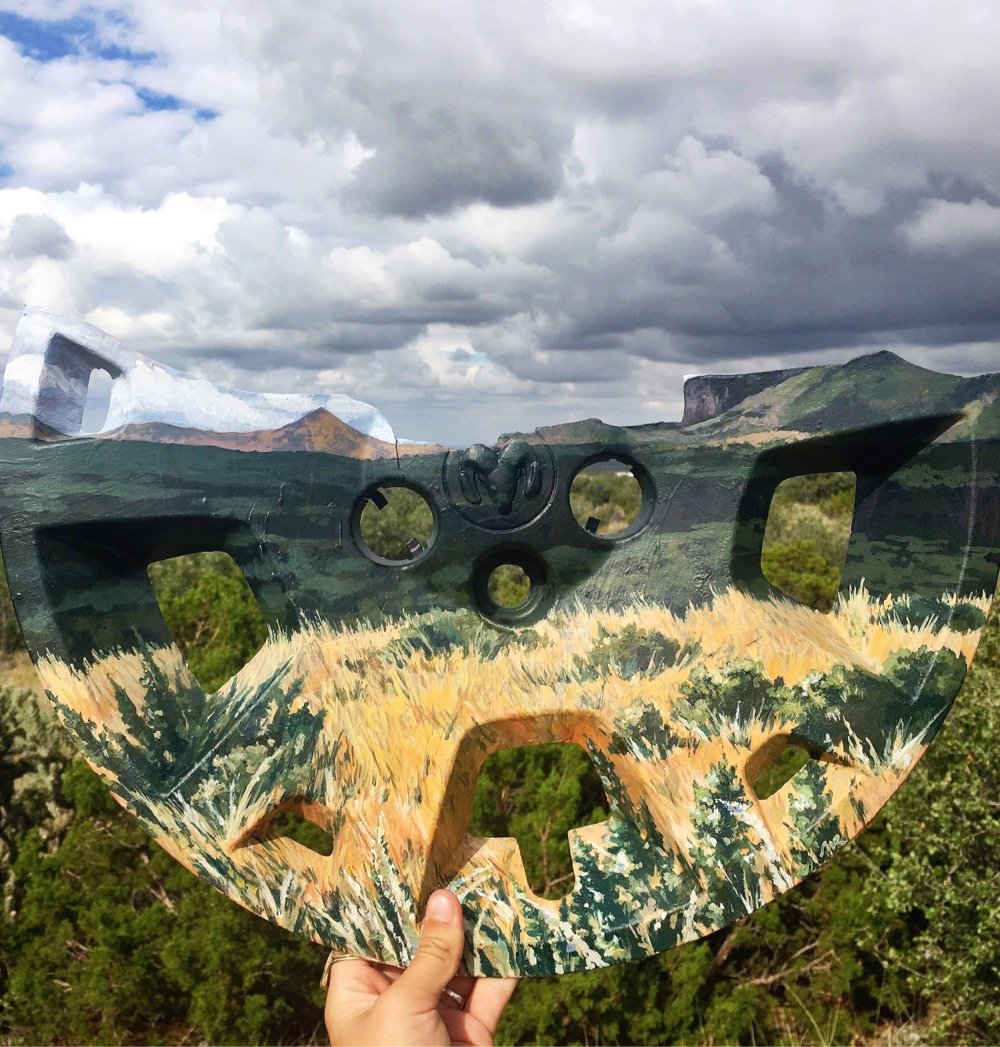

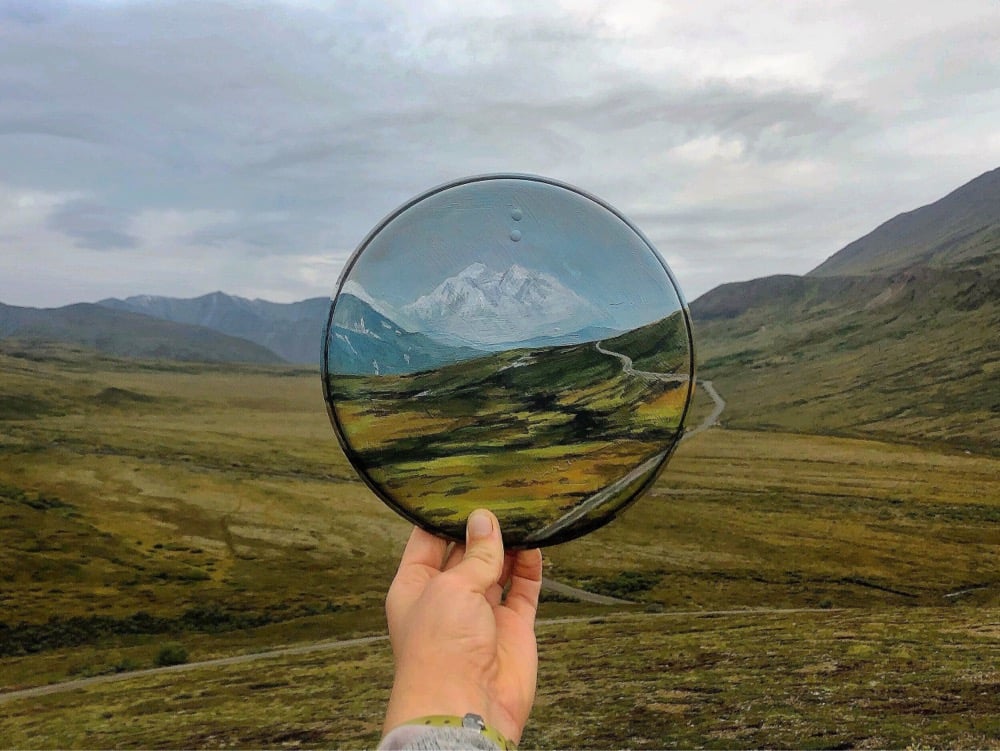
Eco-artist Mariah Reading finds discarded objects in National Parks, on native lands, and in other natural environments and paints impressionistic landscapes on them so they blend into the backgrounds of the places they were found. Atlas Obscura has an interview with Reading about her work.
The first piece I did that was a single object, not a bunch of [objects] stuck together. I was working at Guadalupe Mountains National Park and along its edge there was a major highway. I would walk along it and find a lot of car parts, just a lot of scrap things that fall off as the cars are whizzing past. I found half of a hubcap, and I took a closer look at it and realized it had cracked perfectly to form the silhouette of the mountain range I was standing in front of. I had a vision that I would just paint the land onto it and use the shape of the object to inform the piece. That’s when I started getting more into photography, too. Then my finished work shifted to not just being the painting, but also the painting photographed in the land where it was found.
That piece, called “El (Hub)Capitan”, is pictured at the top of this post. You can check out more of Reading’s work on her website and on Instagram. (via the morning news)
The White House press corps didn’t ask President Biden a single question about the pandemic at his first press conference yesterday. Not one! From @zeynep, here are 10 questions they should have asked him.
The Hard Work of Remembering. “As of today 545,305 people in this country have died from COVID-19. If the names were on the same bronze parapets as the 9/11 memorial, they’d stretch for forty-nine miles.”
Yes, this. But also: I am torn between a) the knowlege that I need to cut *myself* some slack and b) the continuous criticism of myself. Working on it!
Eyes on the Prize to Re-Air on PBS
The fantastic civil rights documentary Eyes on the Prize will soon be available for viewing on public media and online. WORLD Channel and PBS will begin airing the 14-part series in early April. The first part of the series, covering the civil rights movement from 1954-1965, will also be available to watch online starting in mid-April. Check out the press release for more info.
Eyes on the Prize, created by Executive Producer Henry Hampton, is an award-winning and critically-acclaimed in-depth documentary series on civil rights in America. Hampton set out to share his vision of what he called “the remarkable human drama that was the Civil Rights Movement” through the experiences and challenges of those fighting for justice. Produced by Blackside Inc, Eyes on the Prize tells the definitive story of the civil rights era from the point of view of the ordinary men and women whose extraordinary actions launched a movement that changed the fabric of American life and embodied a struggle whose reverberations continue to be felt today.
With contemporary interviews and historical footage, the Academy Award-nominated documentary traces the civil rights movement from the Montgomery bus boycott to the Voting Rights Act; from early acts of individual courage through the flowering of a mass movement and its eventual split into factions. The late Julian Bond, political leader and civil rights activist, narrates.
If you’ve never seen Eyes on the Prize, you should definitely take this opportunity to check it out. (via @jbenton)
Over the past 40 years, Kevin Kelly travelled to 35 countries in Asia, documenting unique cultures before they disappear. The result is Vanishing Asia, a 3-volume book containing over 9000 photographs.
Dominion Voting Systems filed a $1.6 billion defamation lawsuit against Fox News, arguing they lied about Dominion rigging the 2020 election. Sue those fuckers right into the ground.
XXXX Swatchbook, a Book of CMYK Embroidery



Back in January, Clive Thompson asked his Twitter followers for links to books of unusual dimensions. In the resulting thread, people shared images and links to books of all different shapes and sizes, from Irma Boom’s miniature books to the Codex Gigas to a book of Kraft American Singles (my contribution). Designer Evelin Kasikov’s XXXX Swatchbook, a handmade book about CMYK printing constructed entirely of embroidery thread and paper, would fit nicely into that collection.
XXXX Swatchbook shows the range of colours that can be achieved in handmade printing technique. But it also twists the idea of print by turning quick reproduction process into slow handmade process. It’s a book about a process, and with no less than six years in the making, the book itself is a process. It’s a catalogue of colour, a unique art book and an object of book art. The book documents 400 hand-stitched colour swatches in CMYK embroidery. The line screen in my book is incredibly low and ranges between 4 to 7 lines per inch (as opposed to 300 lpi in standard printing).
See also Embroidery that Breaks the Fourth Wall and The Embroidered Computer. (via colossal)
Visualizing deaths caused by policing in the United States. “These three alarming trends…could suggest that the police are becoming increasingly aggressive and invested in maintaining the racial order.”
Moby-Dick in Pictures: One Drawing for Every Page


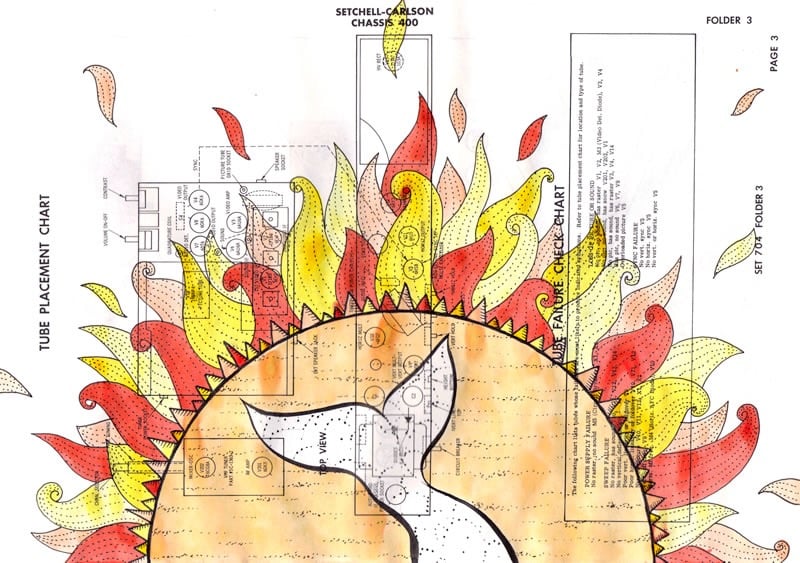
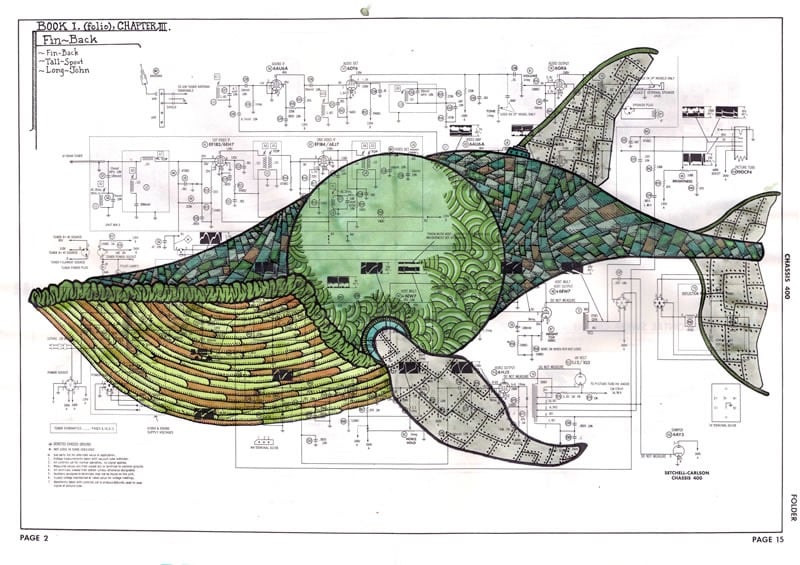
Over a period of a year and a half, Matt Kish created one illustration for each of the 552 pages in the Signet Classic paperback edition of Herman Melville’s novel, Moby-Dick. He then turned those illustrations into a book, Moby-Dick in Pictures: One Drawing for Every Page.
In retrospect, Kish says he feels as foolhardy as Ishmael, the novel’s narrator, and as obsessed as Captain Ahab in his quest for the great white whale. “I see now that the project was an attempt to fully understand this magnificent novel, to walk through every sun-drenched word, to lift up all the hatches and open all the barrels, to smell, taste, hear, and see every seabird, every shark, every sailor, every harpooner, and every whale,” he says. “It was a hard thing, a very painful thing, but the novel now lives inside me in a away it never could have before.”
All of the drawings are still available on Kish’s old Blogspot blog (first entry here) but the best way to see them is to get the book.
New study finds that tax evasion is rampant among America’s wealthy: more than 20% of their income goes unreported, to the tune of $175B/yr. The underfunded IRS doesn’t have the resources to investigate this theft.
Portraits of New Yorkers in Their Apartments
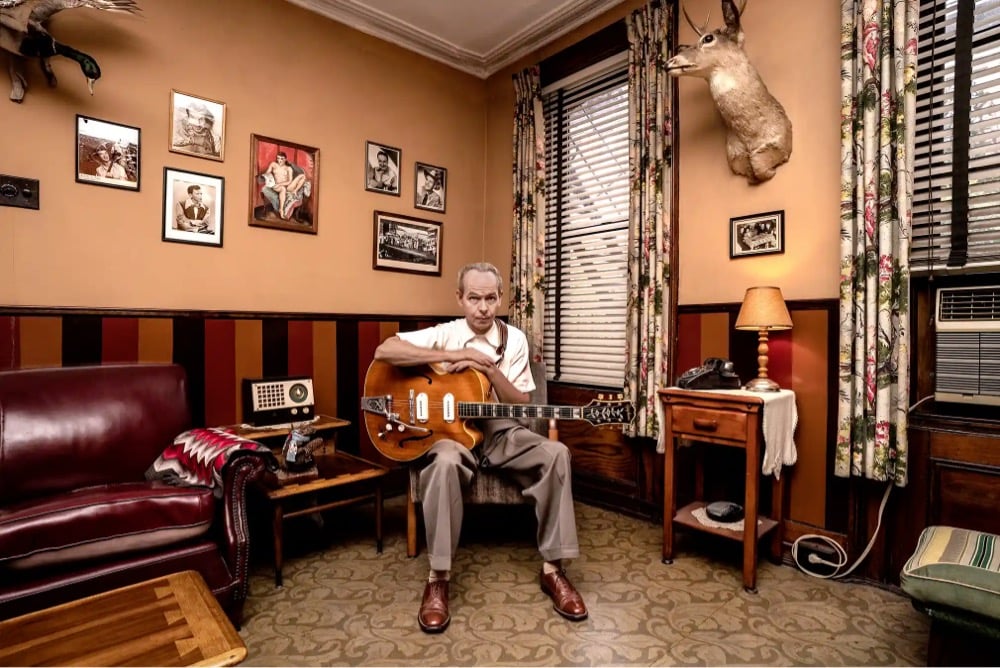

For her forthcoming book New Yorkers, photographer Sally Davies (Instagram) captured portraits of people inside their NYC apartments. I love the creativity of these living spaces, many in styles you just do not see in contemporary design magazines. You can preorder New Yorkers at Bookshop.org — it comes out April 1.
For some reason, my teen son has become obsessed with the “Dicky Moe” episode of Tom & Jerry. To be fair, the first 40 seconds are a brilliant animated distillation of Captain Ahab’s deranged whale obsession.
New Alan Turing £50 Banknote Revealed

The Bank of England unveiled the final design of the new £50 banknote honoring mathematician and computer scientist Alan Turing.
Commenting on the new note, Governor Andrew Bailey said: “There’s something of the character of a nation in its money, and we are right to consider and celebrate the people on our banknotes. So I’m delighted that our new £50 features one of Britain’s most important scientists, Alan Turing. Turing is best known for his codebreaking work at Bletchley Park, which helped end the Second World War. However in addition he was a leading mathematician, developmental biologist, and a pioneer in the field of computer science. He was also gay, and was treated appallingly as a result. By placing him on our new polymer £50 banknote, we are celebrating his achievements, and the values he symbolises”.
The note will be placed into circulation beginning June 23, 2021. As part of the introduction of the note, GCHQ (the successor agency to the one Turing worked for) has created a series of 12 puzzles for folks to decipher. Good luck!
Cool Voice Lag Ventriloquism
In a sort of self-ventriloquism move, Gracie Scullion has learned how to make it seem as though her voice is delayed when she talks. Check out the video to see what I mean:
Neat! Scullion has a career in vaudeville ahead of her if she wants.1 (via digg)
Vine and TikTok are just digital vaudeville. Thanks for coming to my TED Talk (which is also kinda vaudeville, come to think of it).↩
“Virginia, the state that has executed more people than any other in the nation, is abolishing the death penalty today.” It’s the first formerly Confederate state to do so.
Why Comparing Different Covid-19 Vaccines is Difficult
Related to my post from last month about what a 95% or 66% efficacy rate of a vaccine even means, Vox made a clear and concise video about why comparing vaccine efficacy rates is difficult — trials were done in different countries with different variants under different conditions with different levels of disease — and why protection against severe illness, hospitalization and death is a better way to compare and evaluate these vaccines. As this chart from Dr. Eric Topol shows, all of the major vaccines show strong protection against severe illness.

This short paper shows a dramatic difference in infection rates between staff at a Texas hospital who received Covid-19 vaccinations and those who did not. Worrying stat tho: even though they had access, 22% of staff remained unvaxxed.
Seal Skin Spacesuit Made by Inuit Artists
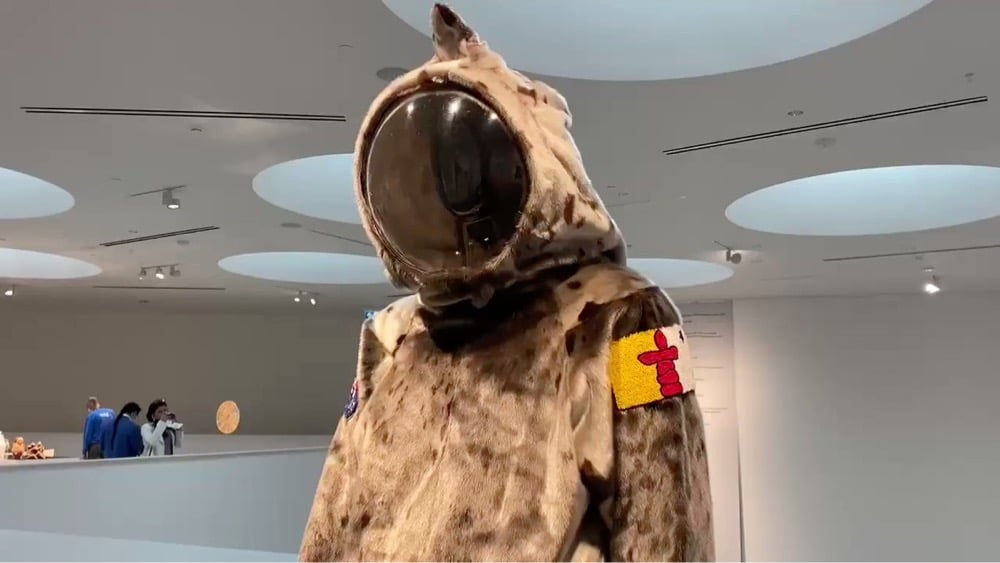
Working with Dr. Heather Igloliorte at Montreal’s Concordia University, Inuit artist Jesse Tungilik and a group of students designed and built a spacesuit made out of seal skin. Tungilik was inspired by the feelings he’d had as a child, bundled up in hunting clothes made by his mother out of caribou hide.
When Jesse Tungilik was a child, his mother made him traditional caribou hunting clothes. While wearing the bulky, heavy handmade outfit, he often imagined that he was in a spacesuit.
“That memory stuck with me when I heard about this opportunity here at Concordia, with its future-themed focus, and the two ideas met in the middle,” Tungilik says.
The image above is a still from a video taken by Brittany Hobson of the spacesuit on display in an exhibition at the Qaumajuq museum in Winnipeg. She says “the video doesn’t do it justice” but the suit looks pretty amazing in that video — I would love to see this in person someday. Dr. Igloliorte, who co-curated the exhibition, talked about the suit and its creation in this video:
Via CBC, you can see a photo of Tungilik as a kid, bundled up in his homemade “spacesuit” while out hunting with his father. Aww. (via @UnlikelyWorlds)
Wow, George Oates has returned to Flickr to revitalize fantastic Commons on Flickr program she launched back in 2008. What great news – The Commons is one of the web’s true gems.
“In City After City, Police Mishandled Black Lives Matter Protests.” Mishandled? Or deliberately escalated? Police intentionally rioted in American streets last summer as a show of force & a rebuke to any restriction of their power & autonomy.
The Growth of London, 47 ACE to the Present
Ollie Bye has created an animated time lapse of the growth of London from a small Roman town in 47 ACE to the largest city in the world (during the Victorian era) to the massive, sprawling city it is today.
See also Here Grows New York City, a Time Lapse of NYC’s Street Grid from 1609 to the Present, an example of what the creator called “an abstract representation of urbanism”. And a list of the largest cities throughout history — perhaps surprisingly, there have only been two lead changes since the 1820s. (via open culture)
On the Americal ritual of a Killing Day. “Mass shootings are by now a standard part of American life. Preparing for them has become a ritual of childhood.”
Animated Folding Screen of Painted Sekigahara Landscapes
Riffing on a byōbu folding screen of the Battle of Sekigahara painted in the 1700s, Yusuke Shigeta made a pixel animated version for a recent exhibition. The video above is a tantalizingly short preview of the work — I could have watched these tiny pixel vignettes all day.
Amazon Delivery Drivers Forced to Sign ‘Biometric Consent’ Form or Lose Job. Amazon could be a beloved company (and still hugely profitable) if they wanted to be but it just doesn’t seem like they want to be.
Pickup lines generated by AI. “What’s the definition of a femtometer? Cause I’d like to run it through your quark 10 times.”
The Advantages of Political Buffoonery
From a short piece riffing on Idi Amin and the political utility of being a buffoon by Mark Leopold, author of an Amin biography:
What, then, are the advantages of political buffoonery? Off-hand, considering Amin’s career, I can think of at least five:
1) It leads opponents to underestimate the ability and intelligence of the buffoon.
2) It provides deniability — “it was only a joke.”
3) It appeals to core supporters (many Africans loved Amin’s teasing of the former colonial masters).
4) It serves as a distraction from the more serious, perhaps frightening or incompetent, actions of the leader, what we now call the “dead cat” tactic.
5) It leads to ambiguity (was it a joke or not?), producing confusion and uncertainty about how to respond.
Behind all this is clearly what Freud recognized as the aggressive nature of joking. I suggest that buffoonery is, at root, a quintessentially masculine characteristic.
If you’ve lived though recent UK and US politics, I expect you’re furiously nodding your head at all this right now. (via sam potts)
How to Wait in Line. “Distract yourself to pass the time. If you can, embrace the camaraderie of wanting something en masse.”
30 Cover Songs Better Than the Originals
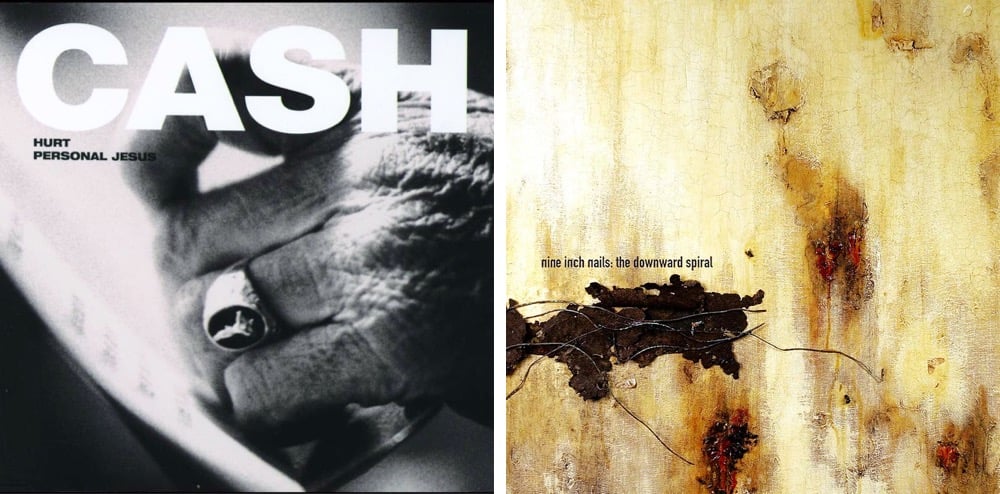
Back in 2011, NME listed 30 cover songs that are better than the originals, as determined by their writers and readers. I’m not going to weigh in on the truth of their assertions, but listening to this playlist of the covers and the original songs is a pretty good way to pass the time.
(via @philipkd)
Update: My friend Matt Haughey thought this list sucked and made his own selections. Something I had forgotten: Matt was responsible for the bootleg of the Ted Leo Since U Been Gone / Maps mashup.
Also, the Coverville podcast has done more than 1350 episodes featuring all sorts of cover songs. (via @john_overholt)
For a limited time, the ebook version of Charles Mann’s excellent 1491 is on sale for $2.99. This book rearranged my brain when I read it in 2005.
Ten people were killed in a mass shooting in Boulder, Colorado supermarket yesterday. In America, part of opening back up after a pandemic is the return of periodic public slaughter. (Gun sales surged massively in 2020.)
Sylvia Plath’s Food Diary. The poet wrote about food a lot and @whatsylviaate is keeping track. “God, must I lose it in cooking scrambled eggs for a man?”
Mickey Drexler tells the Old Navy origin story. “I did some research and found that 80% of the jeans in America sold for less than $30, and Gap’s price point started at $34.50.”
A Giant Banana Orbiting the Earth
What if a giant banana was orbiting the Earth at the same distance as the ISS? What would that look like? Well, it would look something like this.
See also If the Planets Were As Close As the Moon.
Who can and can’t get vaccinated right now around the world. While I wait my turn, I’ve learned there’s no polite way to ask friends my age and younger how they’ve gotten vaccinated already.
Incredible Drone Videos of an Erupting Volcano
After a series of thousands of tiny earthquakes in the area, a small volcano has started erupting in Fagradalsfjall, Iceland. Drone pilot Bjorn Steinbekk took his brand new DJI FPV drone and flew it right into the eruption, capturing this pair of amazing videos. Said Steinbekk of the experience: “I really thought I would never see my drone again, but man, this was so thrilling to capture!!!”
Update: Here’s a live view of the erupting volcano.
Update: Steinbekk has added several new drone videos of the volcano to his YT account, including this fantastic night view of the lava from directly overhead.
Update: Steinbekk did a 12-hour stream from the volcano the other day and at the end, he sent the drone into the volcano to die:
It’s hard to describe in words, but I have actually been very emotional this morning, crying and sad but also so thankful for this experience and being able to share it with you. I realised last night when I took a walk down to say goodbye to this magnificent phenomenon that you can fall in love with a volcano.
This is wild: people vary in how fast they age. “The slowest ager gained only 0.4 ‘biological years’ for each chronological year in age; in contrast, the fastest-aging participant gained nearly 2.5 biological years for every chronological year.”
As spiders age, they produce less web and their feet lose some of their grip. So this person added some climbing aids to help her pet spider climb to a favorite spot.
Perfect Shadows
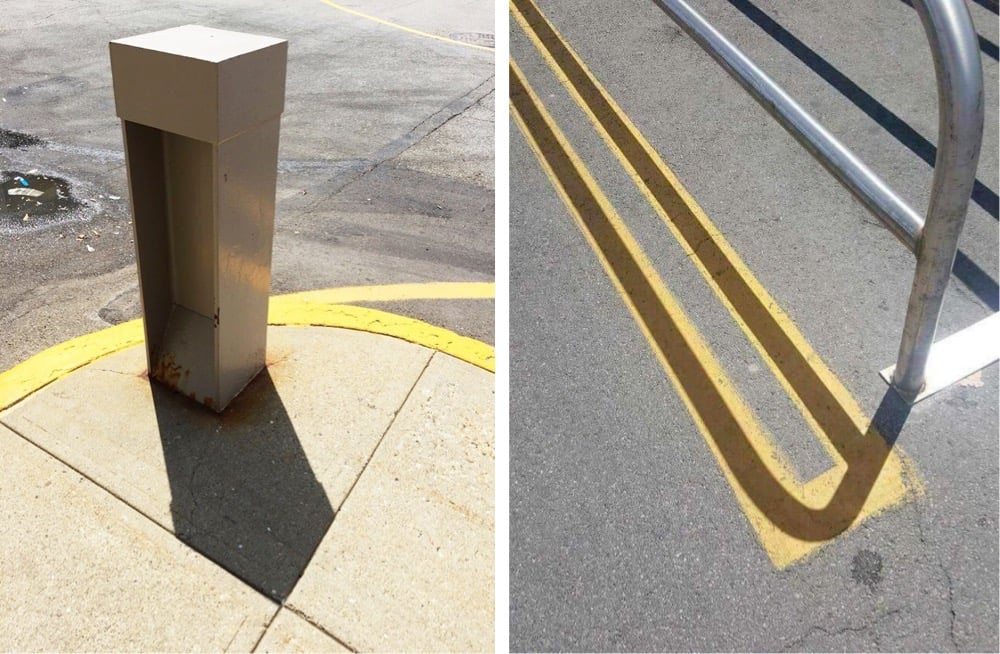
Joaquim Campa recently shared some satisfying shadows for perfectionists. I guess I must be a perfectionist because those shadows are indeed deeply satisfying and calming to me, like fitting the last puzzle piece after hours of work.
More satisfying things: these animations, a race car loses a wheel, unslicing a tomato, and Japanese wood joinery. Or, check out the most unsatisfying things in the world.
How to Safely Remove Bees for Relocation
This video of beekeeper Erika Thompson removing a hive of bees from the floor of an old shed was absolutely riveting! I loved every minute of it. Working without a beekeeping suit or even gloves, Thompson begins by locating the hive with a thermal imager, cuts open the floor, and gently lifts up the flooring to reveal the hive. After transferring the hive’s honeycomb to a new box hive, she cajoles the bees into their new home through the use of smoke, relocating the queen, and even scooping them in there with her bare hand. She ends the video with “and it was another great day of saving the bees” and that’s 100% right.
You can watch more videos by Thompson on YouTube, including this longer one of her removing bees from a camper. You can also check out her work on Instagram or read about how she started her company, Texas Beeworks.
“I didn’t become a beekeeper because I wanted to sell honey, and I think that’s what separates me from a lot of other beekeepers,” she says. “Whatever way you’re inspired by bees or to keep bees I think is wonderful. But in full transparency … I’d rather focus on creating more bees than having them produce more honey.”
Her videos have been going viral on TikTok lately, which led to an appearance on the Today Show, where she explained why she was working without protective gear.
“Most honey bees are very gentle. They’re docile and they don’t want to sting you. I’ve been doing this for a long time and over the years I’ve learned to read the bees’ behavior and these were just very calm, gentle bees. They were also very cooperative and got into their new hive. This was just one case where I could work without gear and it was safer for me and the bees.”
(via austin kleon)
Update: Pro tip: always have an extra queen on hand, just in case — it might just help you have another great day of saving the bees. (via @lauraolin)
The Invention of a New Pasta Shape
For the past three years, Dan Pashman of The Sporkful podcast has been on something of a mission: to invent a new pasta shape. All of Pashman’s hard work has paid off with the debut of cascatelli pasta, available for sale from Sfoglini.
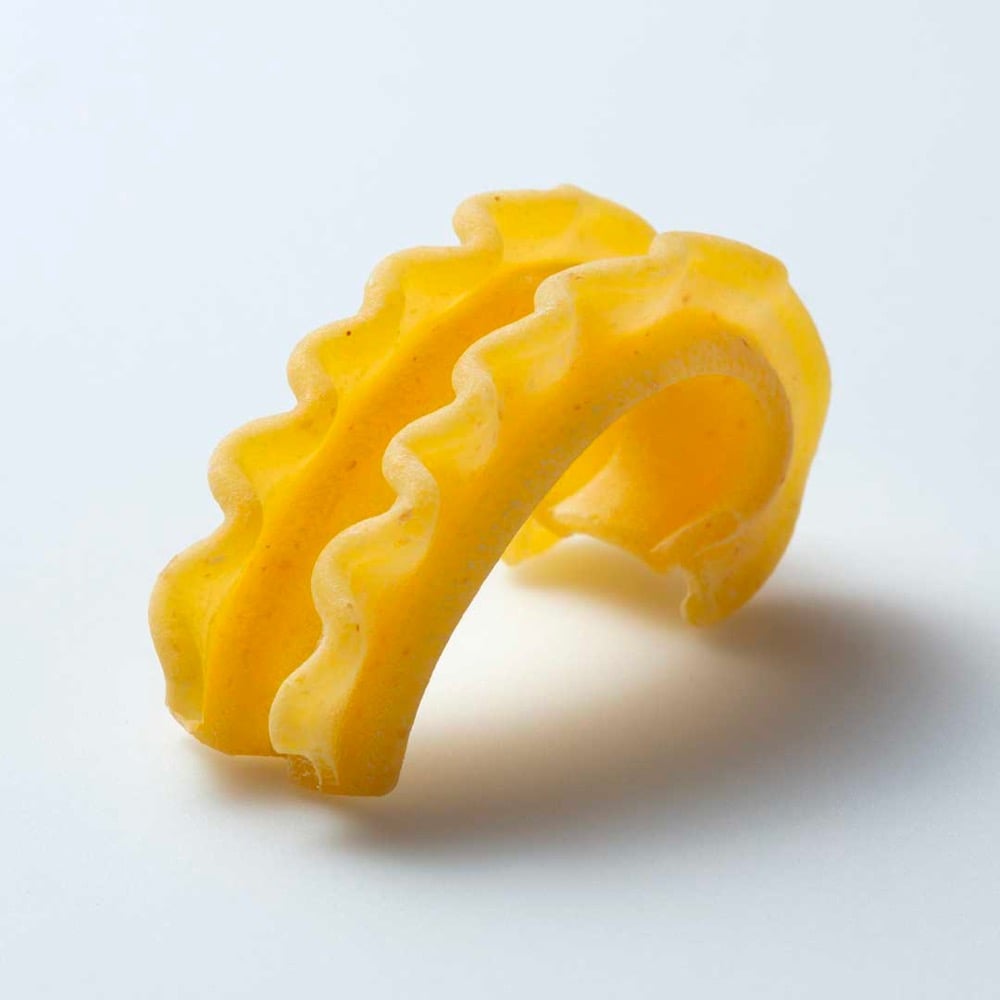
Pashman and Sfoglini engineered the new shape to maximize the amount of sauce that sticks to it, make it easier to get your fork on it, and have it feel good when you bite into it.
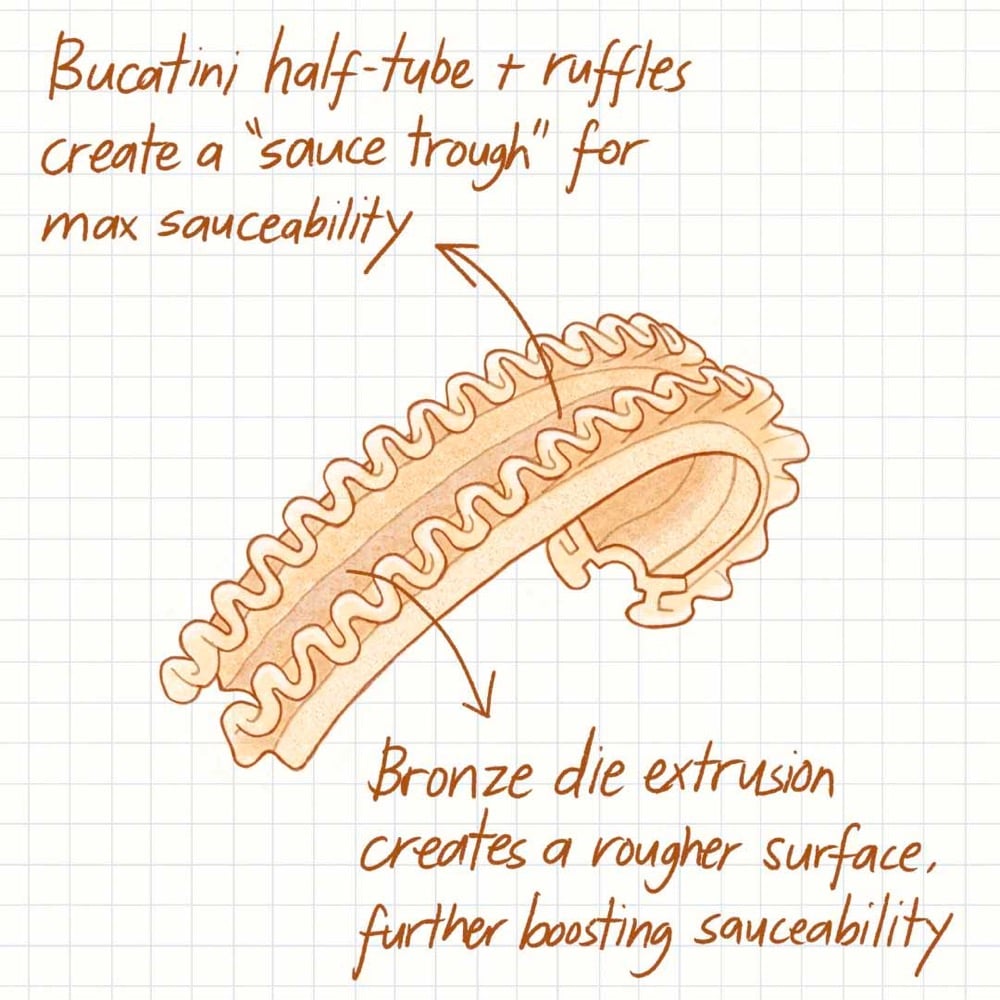
Cascatelli is designed to maximize the three qualities by which Dan believes all pasta shapes should be judged:
Sauceability: How readily sauce adheres to the shape
Forkability: How easy it is to get the shape on your fork and keep it there
Toothsinkability: How satisfying it is to sink your teeth into it
Pashman documented the invention of cascatelli in a 5-part series on The Sporkful podcast — you can listen to the first episode here — and on Instagram. You can order some cascatelli to try it out at home, but it looks like they are currently sold out of everything aside from 5-lb bulk bags.
See also How to Make 29 Different Shapes of Pasta by Hand and 150 Different Pasta Shapes.
NASA Tournament to Determine the Best Photo Taken from the ISS


NASA’s Earth Observatory is holding a single-elimination tournament to find the best photograph taken by an astronaut from the International Space Station. Round 2 is now underway, with 16 photos duking it out for the top spot. The winners are determined by public vote, so get in there and vote for your favorites! (via @thelastminute)
Cookie Consent Speed Run. How quickly can you decline all the cookies? “This game uses all the text and tricks of normal cookie consent pop-ups and banners, so don’t blame me if it’s too hard.”
An extensive analysis of the timing of Covid-19’s emergence. “It is highly probable that SARS-CoV-2 was circulating in Hubei province at low levels in early-November 2019 and possibly as early as October 2019, but not earlier.”
What If the Earth Turned to Gold?
For their latest video, Kurzgesagt ventures into What If? territory with a hypothetical exploration of what would happen if King Midas turned the entire Earth into gold. This video did not go where I thought it was going to. Ten minutes of freefall? Shrinking mountains?
Why Does Mount Everest’s Height Keep Changing?
Back in December 2020, Nepal and China announced that the height of Mount Everest had been remeasured and updated from a height of 8,848 meters (29,028.87 feet) to 8,848.86 meters (29,031.7 feet). Did the mountain get taller? Or the measuring more precise? And how do you measure the height of a mountain — or “sea level” for that matter — anyway?
In December of 2020, China and Nepal made a joint announcement about a new measurement for Mount Everest: 8,849 meters. This is just the latest of several different surveys of Everest since the first measurement was taken in 1855. The reasons why the height has fluctuated have to do with surveying methodology, challenges in determining sea level, and the people who have historically been able to measure Everest.
Also worth noting the (romanised) Nepalese and Tibetan names for the mountain: Sagarmāthā and Chomolungma. The section on its name at Wikipedia is pretty interesting — apparently George Everest, for whom the mountain was named, pronounced his name differently than we all do today.
Radiohead, From The Basement
From the Basement was a series of musical performances from groups like The White Stripes, Radiohead, Gnarls Barkley, PJ Harvey, and Sonic Youth recorded in the late 2000s. Above, Radiohead performs a 55-minute set of music mainly from In Rainbows (there’s also a set from King of Limbs). You can check out more performances from the series here or in their playlist of full sets. (via open culture)
Full? Self? Driving? Hmmm…
How is Tesla’s full-self driving system coming along? Perhaps not so good. YouTuber AI Addict took the company’s FSD Beta 8.2 for a drive through downtown Oakland recently and encountered all sorts of difficulties. The video’s chapter names should give you some idea: Crosses Solid Lines, Acting Drunk, Right Turn In Wrong Lane, Wrong Way!!!, Near Collision (1), and Near Collision (2). They did videos of drives in SF and San Jose as well.
I realize this is a beta, but it’s a beta being tested by consumers on actual public roads. While I’m sure it works great on their immaculate test track, when irregularities in your beta can easily result in the death or grave injury of a pedestrian, cyclist, or other motorist several times over the course of 30 minutes, how can you consider it safe to release to the public in any way? It seems like Level 5 autonomy is going to be difficult to manage under certain road conditions. (via @TaylorOgan)
The Curious World of Animals. “Take a glimpse at the natural world which surrounds us in this groundbreaking documentary that nobody asked for.”
Whiteness is a Pandemic
Damon Young, writing in the wake of the racially motivated murders in Atlanta yesterday:
Whiteness is a public health crisis. It shortens life expectancies, it pollutes air, it constricts equilibrium, it devastates forests, it melts ice caps, it sparks (and funds) wars, it flattens dialects, it infests consciousnesses, and it kills people — white people and people who are not white, my mom included. There will be people who die, in 2050, because of white supremacy-induced decisions from 1850.
My Mom Believes In QAnon. I’ve Been Trying To Get Her Out.
Map of the Names of Donald Duck’s Nephews in Different Countries
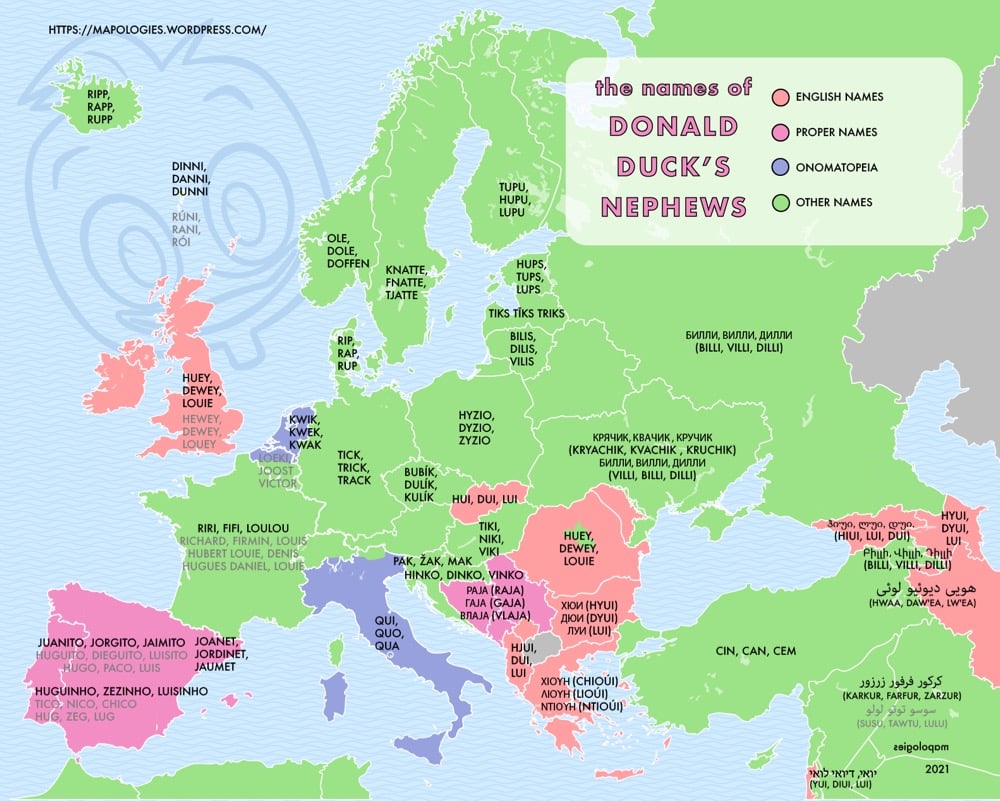
In the US and other English-speaking countries, the names of Donald Duck’s three nephews are Huey, Dewey, and Louie. As this map shows, they have different names in other countries — like Tick/Trick/Track in Germany, Billi/Villi/Dilli in Russia, and Ripp/Rapp/Rupp in Iceland.
You should check out the rest of the maps on the Mapologies blog as well, including maps of what the Milky Way is called in different countries and what people say when toasting.
Fans Build Life-Size Model of the Razor Crest from The Mandalorian
Some Star Wars fans in Yakutsk, Russia (aka one of the coldest inhabited places on Earth in the winter) spent the last few months building a life-size replica of the Razor Crest spacecraft from The Mandalorian. It was self-financed at the beginning (one of the creators sold his car) but attracted some sponsorship as construction progressed.
The Responsibility of Saving Restaurants Should Never Have Been Ours. “By refusing to act, the government effectively told diners that workers’ livelihoods and lives were in their hands.”
Good thread from Linsey Marr summarizing her House testimony about the airborne transmission of Covid-19. Ppl working in gas stations here in VT still routinely go unmasked behind plexi partitions; drives me nuts!
Stone Lithography
Well, add stone lithography to the list of cool hobbies I will do once I’m done sitting in this chair watching videos about things like stone lithography.
Henri de Toulouse-Lautrec revolutionised the world of graphic design with his striking posters at the end of the nineteenth century. This was in some ways due to his innovative approach to stone lithography to create his colourful designs.
If you think this video is too brief, you can check out this longer one. (via the kid should see this)
How Sperm Whales Learned to Collectively Outsmart 19th-Century Whalers
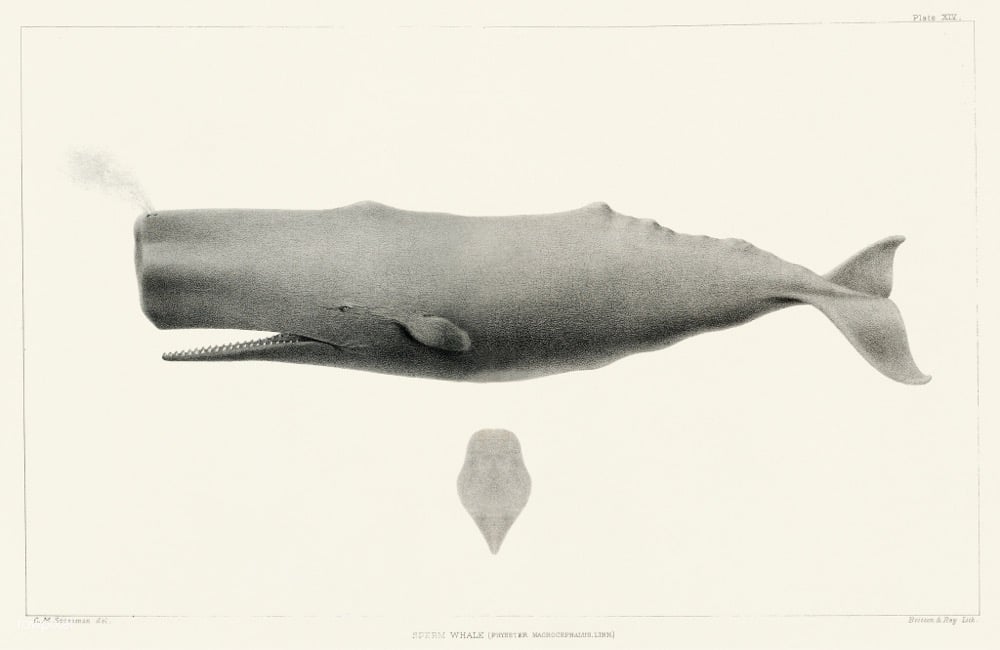
In the 19th century, when whaling fleets were first sent out to hunt sperm whales, the whales employed the same defensive strategy they used against orcas: forming the group into a tight circle. But what worked against orcas was not successful against whalers: the close grouping made the whales that much easier to kill. According to a recent analysis of whalers’ logbooks, within a few years the sperm whales collectively abandoned the grouping strategy in favor of swimming upwind from the sailing ships to escape.
Sperm whales are highly socialised animals, able to communicate over great distances. They associate in clans defined by the dialect pattern of their sonar clicks. Their culture is matrilinear, and information about the new dangers may have been passed on in the same way whale matriarchs share knowledge about feeding grounds. Sperm whales also possess the largest brain on the planet. It is not hard to imagine that they understood what was happening to them.
The hunters themselves realised the whales’ efforts to escape. They saw that the animals appeared to communicate the threat within their attacked groups. Abandoning their usual defensive formations, the whales swam upwind to escape the hunters’ ships, themselves wind-powered. ‘This was cultural evolution, much too fast for genetic evolution,’ says Whitehead.
See also Studying Humpback Whales to Better Communicate with Aliens.
Hollaback! is offering free bystander intervention training to help stop Anti-Asian/American and xenophobic harassment. Even if you can’t do the training, check out the resources at the bottom of the page.
Art heist! Houston’s Rienzi House Museum was (maybe) robbed last night. The thieves escaped by motor boat, disappeared into a drainage tunnel, and are still at large. Still unclear if anything was actually taken…
Tintype Portraits of the Cast of Little Women



Photographer Wilson Webb made these great tintype portraits of the cast of Little Women. Invented in 1851, the collodion process would have been in use during the time the movie takes place. You can read about Webb’s process at PetaPixel.
To capture the actual portraits, Webb got his hands on a 130-year-old Dallmeyer lens that he strapped to a modern large format camera, and set up 25,000 Watt-seconds worth of flash to ensure he had enough light. That’s… a lot of light. So much that Webb says his subjects “can feel a wave of heat and they can also smell the ozone that’s created when the picture’s taken.”
But despite all of this light — which allowed him to capture a much faster “shutter speed” than traditional wet plates — he still had the cast pose in a traditional fashion: facing the camera, stoic expression, sitting still for 30 seconds at a time to capture each individual frame.
You can check out the whole series of portraits at My Modern Met.
The US is sitting on a stockpile of AstraZeneca Covid-19 vaccine doses that we won’t be able to use. Send them to countries that can use them to save lives!
Horrific: eight people were murdered (7 women, 6 of Asian descent) by a white man in three different locations in the Atlanta area yesterday. Let’s call this what it is: white supremacist terrorism fueled by easy access to guns.
Here’s what living with Long Covid for a year is like. “Until November I had a racing heartbeat and my HR would shoot up anytime I used my arms while standing.”
Shakespeare in the Park is returning to NYC’s Central Park this summer! Civilization is healing…
Lessons for the Next Pandemic. “To prepare for the next pandemic, the government must put science and data above all else.”
Listen to Wikipedia
Wikipedia is a constantly changing entity with hundreds of edits occurring every minute and now you can experience that dynamism as ambient music: Listen to Wikipedia. Additions, subtractions, and new user signups to the site are tracked as they happen and represented as different tones — here’s a video recording from a few years ago:
Bells indicate additions and string plucks indicate subtractions. Pitch changes according to the size of the edit; the larger the edit, the deeper the note. Green circles show edits from unregistered contributors, and purple circles mark edits performed by automated bots. You may see announcements for new users as they join the site, punctuated by a string swell.
(via open culture)
Life After Vaccination
I thought this interview with Dr. Ashish K. Jha, dean of the Brown University School of Public Health, was really good and useful in terms of calibrating expectations with regard to the “end” of the pandemic, vaccines, and variants. On the guidance that vaccinated people should be getting:
I think it is essential that we give guidance to people. And I think we should give guidance to people on what they can do safely once they are vaccinated. People say, “Can your behavior change?” My answer is: absolutely! That’s a major motivation for getting vaccinated. First of all, what’s very clear to me is vaccinated people hanging out with other vaccinated people is pretty darn close to normal. You don’t have to wear a mask. You can share a meal. The chance that a fully vaccinated person will transmit the virus to another fully vaccinated person who then will get sick and die … I mean, sure, people get struck by lightning, too. But you don’t make policy based on that. And we need to remind people that there is a huge benefit to getting vaccinated, which is that you are safe enough to do the things you love with other vaccinated people.
On the unrealistic expectations of the American system of work. “Long before Covid-19 hit, Americans were expected to work like they didn’t have families.”
Endangered Insect Stamps
Via Steven Heller at Print, I ran across these lovely insect stamps designed by Osborne Ross for the Royal Mail.


And check out this other stamp project of theirs, featuring these irregularly shaped stamps that playfully wrap around the edges of the letters:

So good!
The Logo Quiz. How well do you know tech company logos?
Cryptocurrency Explained
I run across this immaculate one-line explanation of Bitcoin/cryptocurrency every few months and today I finally decided to save it here for posterity:
imagine if keeping your car idling 24/7 produced solved Sudokus you could trade for heroin
*applause*
Evidence from Israel that their aggressive vaccination efforts are working. Look at that steep, steady drop in hospitalizations in the 60+ age group.
Yo-Yo Ma Plays Impromptu Cello Concert at Covid-19 Vaccination Clinic After Getting Second Dose
After getting his second dose of the Covid-19 vaccine at a clinic at Berkshire Community College, Yo-Yo Ma got out his cello and performed a 15-minute impromptu concert for the others folks at the clinic.
When Ma had first visited the clinic for his first shot, he did so quietly, taking in the surroundings, staff said. But brought his cello when he returned for the second shot.
Staff described how a hush fell across the clinic as Ma began to play. “It was so weird how peaceful the whole building became, just having a little bit of music in the background,” said Leslie Drager, the lead clinical manager for the vaccination site, according to the Washington Post.
Why is it weird? Music is amazing. I know you could never get such a “frivolous” spending measure through an American deliberative body these days, but how awesome would it be for the government to commission out-of-work musicians to play at vaccination clinics? Ok maybe you couldn’t have anyone sing and the brass & woodwinds would probably have to sit this one out, but you could have strings, guitars, percussion, pianos, DJs, etc. there to play some relaxing, uplifting, or energetic music, according to local custom & culture. Bring back the WPA!
It’s Been 23 Years
On March 14, 1998, I started writing here and, aside from a month or two here and there, never stopped. Things just kinda got out of hand, I guess. *shrug* I keep thinking that at some point, someone is going to inform me that vaudeville is over and yank me off stage with a hook, but until then you’re stuck with me. Thanks everyone for reading — I know from past emails that some of you have been following along since the beginning.
While I have you, two things:
1) After several months of inactivity, the Noticing newsletter has relaunched as a weekly recap of this here website — it’s got a new design too. You can subscribe here or read the latest issue with the new look.
2) The newsletter and kottke.org are completely free for everyone to read, thanks to financial support from readers like you. If you’d like to support this small corner of an increasingly paywalled web, please consider investing in a kottke.org membership. Thanks!
How to Operate an Airport in Antarctica
This video and blog post look at the challenges of building and maintaining a 3000-meter ice runway in Antarctica. It bears some resemblance to grooming ski slopes and maintaining ice rinks.
Once the snow is removed, the runway is inspected for cracks, pits, or any other deficiencies that would prevent a safe landing. These are repaired by crews with a mixture of cold water, ice chips, and snow that is poured on, allowed to harden, and then smoothed over.
Finally, two snow groomers with tillers grind a small layer of ice to create a top layer of crushed snow and ice that gives the runway the necessary friction for aircraft to operate. Lidström points out that equipment at Troll isn’t necessarily purpose built, ‘These are the same machines that you see on ski slopes, but with a tiller grinder attached.’
There’s even a small terminal with bathrooms and wifi, amenities which aren’t available at all Antarctic airfields.
How Were the Covid-19 Vaccines Developed So Quickly?
According to a study conducted by the Pew Research Center, among those people who said they probably or definitely won’t get a Covid-19 vaccine, the top two reasons given were “concern about side effects” and “the vaccines were developed and tested too quickly”. For our purposes here, I’m going to ignore the first concern — the data is pretty conclusive that, on average, the vaccine side effects are minimal when compared to the effects of actually contracting Covid-19 — and focus on the quick development timeline. If you’re among those who are apprehensive about the unprecedented speed at which the world’s governments and scientific community mobilized to create several effective Covid-19 vaccines, I hope the following will help you make a good decision.
In reading a bunch of different resources (linked below throughout), I identified six main reasons why the Covid-19 vaccines were developed so quickly compared to past efforts.
1. The need was urgent. Covid-19 changed the entire world in a very short span of time and it was evident in the absence of an effective vaccine, tens of millions more people would unnecessarily die and/or suffer and the rest of us would be living in fear of disease and death. This urgency drove several of the other factors here: the availability of funding, resources, and collaboration.
2. Funding & focus. Companies and governments threw billions and billions of dollars at this. Companies, research centers, and scientists dropped other stuff they were working on to study SARS-CoV-2 and Covid-19. Governments prioritized regulatory approval for trials, etc. From a thread by Dr. Kat Arney:
Relatively few in the scientific, pharma & policy worlds care about vaccines compared w/ drugs. Most vaccine programmes are underfunded as they’re perceived as not profitable, only relevant to LMICs, & have few research groups/companies working on them. Getting funding & research capacity for vax usually takes months/years. COVID-19 vaccine was a massive global research effort w/ $millions for multiple groups/projects in weeks. Years of funding cycles & lab research happened in months, huge amount of time saved.
And from a presentation given by Dr. Anthony Fauci:
We proceeded at risk. So people say, what do you mean by “at risk”? Are you risking safety? Are you risking scientific integrity? No, it’s a financial risk. In other words, you invest in things that cost a lot of money before you even have an answer to whether the prior step worked.
And a classic example is the production of large scale amounts of clinical lots, which have been produced and are being produced before you even know that your vaccine works, so that you have hundreds of millions of doses ready to go. If the vaccine works, you’ve saved many months. If the vaccine doesn’t, you lost a lot of money, to the tune of hundreds of millions if not billions of dollars. But it was felt it was worth that investment and that risk financially in order to save time.
More on that here. As Dr. Faheem Younus put it, “We didn’t cut corners; we cut the crap!”
3. Availability of volunteers & high incidence of disease. In order to statistically show the vaccine works, you need people to test it on and you need enough people in the studies to get sick. Kat Arney again:
To show vax effectiveness, you need a high number of people with the disease in the population — big problem with the Ebola vax is that it took so long to develop the outbreak was over & the couldn’t get enough numbers to conclusively show it worked
We’re in a global pandemic — the vaccine is being tested in places with very high community prevalence, so trials can hit pre-determined statistical milestones very quickly. Huge amount of time saved.
Hundreds of thousands of people around the world volunteered to test these vaccines — without them, we’d be months and years away from a safe, tested vaccine.
4. International & corporate collaboration. Countries and companies shared research, data, and resources because the primary goal was to develop effective vaccines and save lives, not make a profit. For instance, Chinese researchers posted the genome for SARS-CoV-2 on January 11, 2020, allowing the effort to develop a vaccine to begin.
5. We knew a lot about coronaviruses from previous work. This wasn’t an effort that started from scratch. From Bloomberg:
The Pfizer-BioNTech and Moderna vaccines may seem brand new, but they are the culmination of more than a decade of work that started during the SARS and MERS outbreaks. Vaccines were even developed against MERS but were never needed. Nevertheless, scientists learned a huge amount from working with that virus, which is from the same family as the one that causes Covid-19.
From Dr. Habibul Ahsan:
Really, most of the vaccine platform development work is already done. You just have to do the remaining part, which is adding the right viral antigens to the already-proven platform and making sure it’s safe and effective in humans. Even in just the last five to 10 years, we’ve made big leaps in developing new kinds of vaccine platforms like those being tested for SARS-CoV-2.
6. Scientific and technological capability. Ok, we know a lot about coronaviruses but humanity’s general scientific and technological abilities have never been stronger or more powerful. Again from Bloomberg:
Remember also that technology has evolved rapidly — for example, we’re now about able to sequence the genomes of every mutant version of the virus in less than a day. That helps in speeding up vaccine development.
Dr. Mark Toshner sums up the effort:
However we have collectively now shown that with money no object, some clever and highly motivated people, an unlimited pool of altruistic volunteers, and sensible regulators that we can do amazing things.
Further reading: The lightning-fast quest for COVID vaccines — and what it means for other diseases (Nature), How were researchers able to develop COVID-19 vaccines so quickly? (Univ. of Chicago), The race for the COVID-19 vaccine: A story of innovation and collaboration (Carnall Farrar), COVID-19 vaccines: development, evaluation, approval and monitoring (European Medicines Agency).
The Age of Data – Embracing Algorithms in Art & Design. “An anthology of genre-redefining data-based art. Featuring 40 artists, designers and studios.”
Novovax announced that their Covid-19 vaccine is “96% effective in preventing cases caused by the original version of the coronavirus” (phase 3 results). Right up there w/ Pfizer and Moderna. Also 86% effective against B.1.1.7.
Masks of the World
This is an excerpt from a short film called Beyond Noh that cycles through 3,475 different masks from around the world — ceremonial masks, costume masks, gas masks, N95 masks, catcher’s masks, etc. The film is by Patrick Smith (I featured his video Gun Shop a few years back), who told Colossal:
To me, masks are an interesting way to view humanity. It seems to me that every culture in the history of the world has participated in some form of mask making, whether it’s for performance, ritual, protest, or utility.
Compilations like this will always remind me of this clip art movie from 2006 and, of course, Noah Kalina’s Everyday. The full film is available to Smith’s paying members on YouTube. (via colossal)
What’s this, a fresh new design for the Noticing newsletter? You can check it out right here.
Old-school NYC diner Eisenberg’s Sandwich Shop has shuttered. Very sad – I used to work nearby and got takeout lunch there at least once a week.
Modern Trailers for Classic Films
In order to promote the classic films available on the streaming service, HBO Max has created a selection of modern-style movie trailers for them. The re-trailered flicks include Dog Day Afternoon, Boogie Nights, Alien, Casablanca, and The Exorcist.
BTW, because of its Turner Classic Movies section, HBO Max seems like the best big streaming service for watching good, classic movies. It’s become nearly impossible to find anything on Netflix made before 2000, but on HBO Max right now you can watch Rocky, A Clockwork Orange, The 400 Blows, Seven Samurai, THX 1138, Malcolm X, 8 1/2, Solaris, Citizen Kane, Grey Gardens, North By Northwest, Rashomon, Tokyo Story, and dozens of others. (via open culture)
One Year Ago Today
For reasons I do not quite understand, I just spent the better part of an hour reading two oral histories of March 11, 2020, aka the day the United States finally took the Covid-19 pandemic seriously — this one from Wired published back in April 2020 and this one published today by Buzzfeed News. You may not want to relive that day and everything it’s come to signify, but apparently I did. (See also a Twitter search for “year ago today” and Covid One Year Ago.)
Several things happened on 3/11 that made Americans and their government finally realize that our lives were about to significantly change: the stock market plunged, the NBA suspended its season after a player tested positive, the WHO called it a “pandemic” for the first time, Trump addressed the nation and announced a ban on travel from Europe, and Tom Hanks & Rita Wilson announced that they had tested positive for the virus.
Claudia Sahm: Frankly, the night before, the 10th, I was in a bit of a panic because I was worried that I was overreacting. It was like gaslighting the way Trump and Republicans and Fox News would talk about the coronavirus. Like, “We’ve got this one, it’s not a big deal. It’s like the common flu.” Listening to that, I was saying, “We need to get going.” Congress needs to do real things. That morning, I stood in front of the House Democrats at the minority whip breakfast and told them what they needed to do with a relief package. I told the House Democrats that the $8.3 billion package that they had passed the week before was an insult.
DANIEL MERTZLUFFT, director of Ratatouille: The TikTok Musical, who was then in a Broadway theater audience: In the three hours I was seeing Company, the world had changed. I went to drinks after work with friends, one of whom is a business owner that works in theater marketing, and I remember him arriving at the bar and sort of realizing for the first time what it must have been like on the day the Great Depression started. What he said was, “This is not a month; this is going to be months. My business no longer exists. I have to fire my entire team.”
The Trump, Hanks, and NBA news all hit within a period of 30 minutes — I vividly remember being on Twitter and texting w/ friends as the news rolled in that evening. I’d stocked up on food & such during the last week in February and had been fully convinced the day before by this video on the exponential growth of epidemics that this was going to be a world-changing event, but the pace of events that evening was unprecedentedly dizzying. (via the morning news)
Sobering visualization of the 2.3 million Americans currently jailed or imprisoned. “The United States holds more people in jails and prisons than any other country by far, both in absolute numbers and as a percentage of population.”
One year ago today, the reality of Covid-19 finally & dramatically hit the United States. On 3/11/2020, the Dow plummeted, the WHO officially called it a “pandemic”, the NBA suspended its season, and Tom Hanks announced his diagnosis.
Tina
Tina is an upcoming documentary film about music legend Tina Turner, featuring interviews with Angela Bassett, Oprah, Kurt Loder (who co-wrote the 1986 autobiography on which the movie is based), and Turner herself.
With a wealth of never-before-seen footage, audio tapes, personal photos, and new interviews, including with the singer herself, TINA presents an unvarnished and dynamic account of the life and career of music icon Tina Turner.
Everything changed when Tina began telling her story, a story of trauma and survival, that gave way to a rebirth as the record-breaking queen of rock ‘n’ roll. But behind closed doors, the singer struggled with the survivor narrative that meant her past was never fully behind her.
Tina will begin airing on HBO on March 27. A companion playlist of Turner’s music is available at Spotify.
Update: Cassie Da Costa reviewed Tina for Vanity Fair:
Her new interview in the film allows her to speak authoritatively on her own celebrity and personal life without having to revisit the sordid details of the abuse she experienced at the hands of Ike. And though it doesn’t shy away from the darkness held within her biography, Tina turns decidedly toward the light. The result is a film that shines, both in its passion for Turner’s talent and the depth and complexity of her character.
Research suggests that increasing the minimum wage could help lower suicide rates. “So many people who died by suicide weren’t just starving for therapeutic attention. They were starving.”
Lego is going to produce a set featuring Vincent van Gogh’s painting The Starry Night. It’s based on an idea contributed by Truman Cheng, who will receive a 1% royalty from all sales of the set.
Netflix to Air Documentary About the Last Blockbuster Video Store
Netflix was founded in 1997 as a DVD rental service. At the time, Blockbuster Video was a multi-billion dollar video rental behemoth, growing to over 9000 stores as recently as 2004. In 2000, Netflix offered to sell to Blockbuster for $50 million — Blockbuster declined. By 2011, Blockbuster was bankrupt and down to 2400 stores while Netflix had gone public and their streaming business was exploding. Today, Netflix has a market cap of $223 billion, is a member of the S&P 100, and will soon start showing The Last Blockbuster, a documentary about the very last Blockbuster video rental store in the world. Absolutely savage victory lap.
Make-Your-Own Bayeux Tapestry
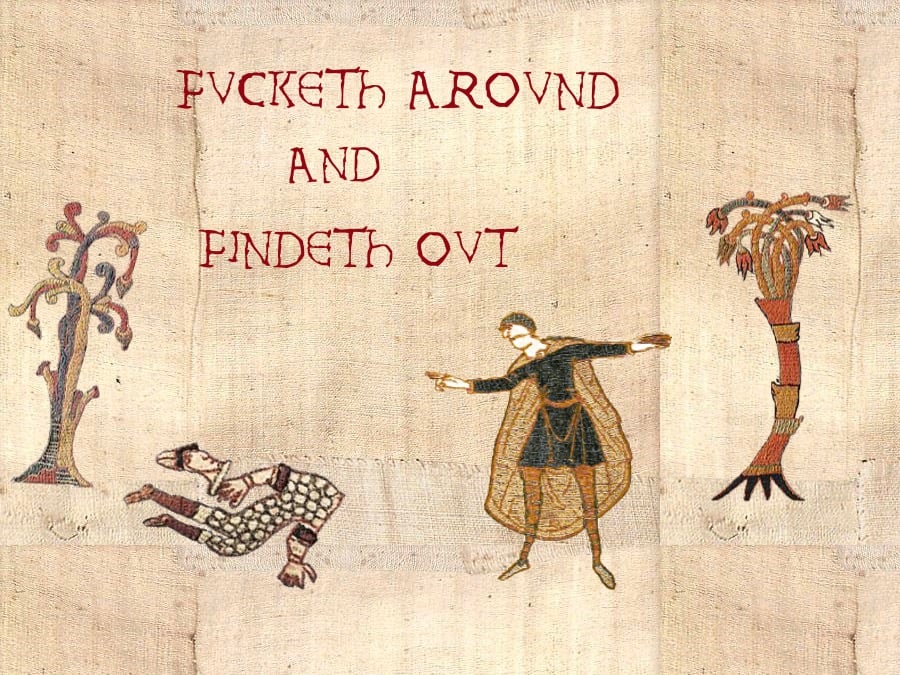
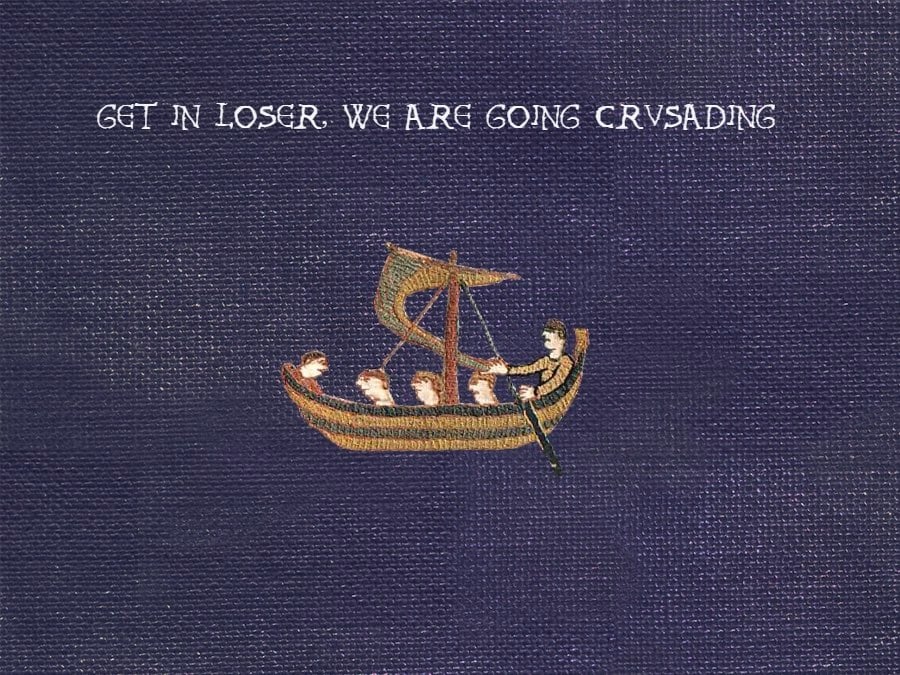


The Bayeux Tapestry is an embroidered cloth from the 11th century that documents the events of the Norman conquest of England. Teacher @profannieoakley recently turned her art history students loose with an online make-your-own Bayeux Tapestry app and their results, as well as some shared by Twitter commenters, are pretty entertaining.
Vivid Images by Noe Alonzo

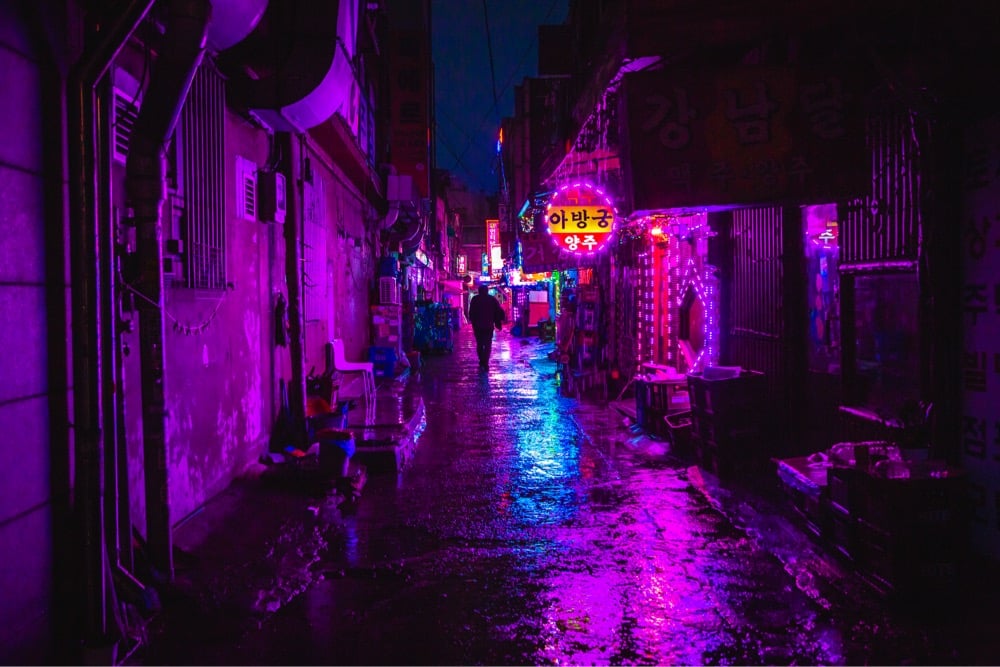
Digging this work from Noe Alonzo. The top image is from his Anime World project and the bottom from a collection of Blade Runner-esque images shot at night. His images are obviously heavily processed — he offers tutorials on his YouTube channel — but what photos aren’t? Very little comes out of the camera looking amazing, which was as true in Ansel Adams’ day as it is today. (thx, @thelastminute)
This study gave $500/mo in no-strings-attached cash to low-income folks for two years. After, recipients were happier, healthier, less anxious, and more likely to have a job. “The best way to get people out of poverty is just to get them out of poverty.”
Ballhaus, the Art of Basketball

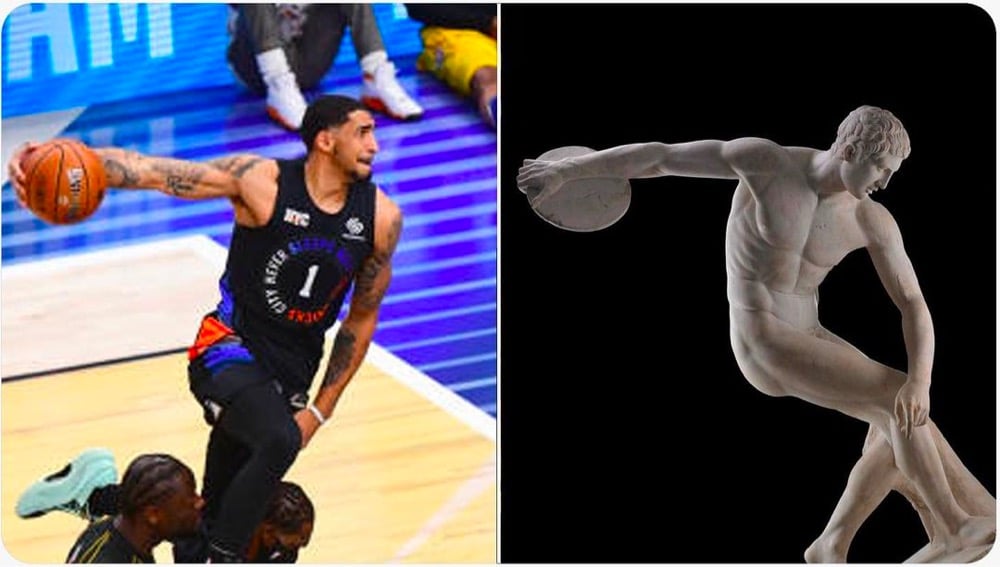

The @ballhaus Instagram acct is pairing photos of basketball players with art. From top to bottom: Luka Dončić × Correggio, Obi Toppin × Myron, C.J. Miles × René Magritte. (via austin kleon)
The Bookshop: One of John Cleese’s Favorite Comedy Sketches
In 2014, John Cleese listed five of his favorite comedy sketches that he had written over the course of his career. Among them was one I’d never seen before but soon had me in stitches: The Bookshop.
I also watched another of the sketches he mentioned (The Cheese Shop) and it fell totally flat — Monty Python-style humor is very much a hit-or-miss thing for me, so YMMV. (via open culture)
In 1977, the “world’s last lost tourist”, bound for San Francisco from Germany, mistakenly got off the plane in Maine. “The rusted green bridge that links Bangor to neighboring Brewer was clearly not the Golden Gate, but Kreuz carried on regardless.”
The Winners of the 2020 World Nature Photography Awards
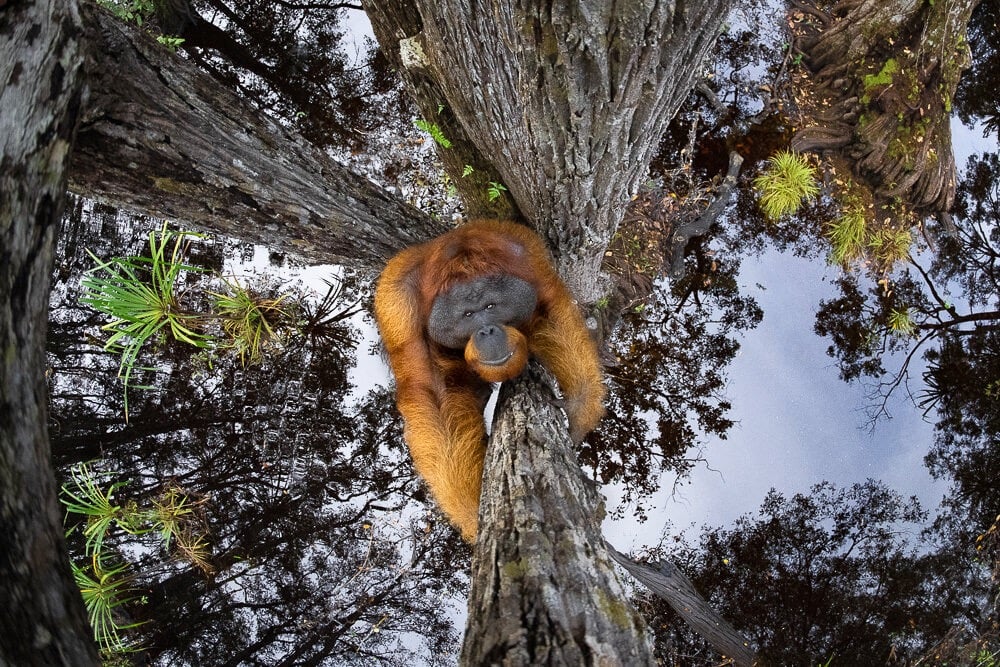

The World Nature Photography Awards have announced the winners of their 2020 competition. Thomas Vijayan’s photo of an orangutan (top) won the overall prize and I enjoyed the optical illusion created by Naomi Rose (bottom). You can see the rest of the winners in several different categories here. (via in focus)
How Looney Tunes & Other Classic Cartoons Helped Americans Become Musically Literate. “Who can hear Wagner without wanting to sing at the top of their lungs, ‘Kill da wabbit, Kill da wabbit, Kill da wabbit!’”
All the Sitcom References from WandaVision Explained
In this extensive video, The Take not only explains the themes and ending of WandaVision (spoilers, obvs) but walks through all of the sitcom tropes, references, and Easter eggs present in the show, from The Dick Van Dyke Show to the beeping Stark toaster commercial to Bewitched to Full House (Olsen sisters!) to The Office. Weirdly, they kinda glide right over perhaps my favorite trope referenced in the show: the recasting of the Pietro character a la Darrin in Bewitched and Aunt Viv in The Fresh Prince of Bel-Air.
The video pairs well with this interview with WandaVision creator Jac Schaeffer.
The first thing was the notion of, how do you do this? How do you take sitcoms and combine them with Wanda and Vision who, up to this point in the M.C.U., were such self-serious characters and dramatic characters with so much sadness surrounding them. They weren’t funny. What’s the synthesis? I’m a big fan of “Lost,” and I was very inspired by shows like “Russian Doll,” “Forever” and “Homecoming.” I relished the opportunity of a slow burn. It seemed like an exciting, sneak-attack way to have a bit of a social commentary and a very large story of character and grief.
I thought how they constructed the entire show was really fantastic — I loved every minute of it.
BirdCast: Real-Time Bird Migration Forecasts

Colorado State University and the Cornell Lab of Ornithology have developed a system called BirdCast that uses machine learning & two decades of historical bird movement data to develop daily bird migration forecasts for the United States.
Bird migration forecasts show predicted nocturnal migration 3 hours after local sunset and are updated every 6 hours. These forecasts come from models trained on the last 23 years of bird movements in the atmosphere as detected by the US NEXRAD weather surveillance radar network. In these models we use the Global Forecasting System (GFS) to predict suitable conditions for migration occurring three hours after local sunset.
The map above is the migration forecast for tonight — overall, warmer temperatures and increased bird movement are predicted for the next week or two. They also maintain up-to-the hour records of migration activity detected by the US weather surveillance radar network; this was the activity early this morning at 3:10am ET:
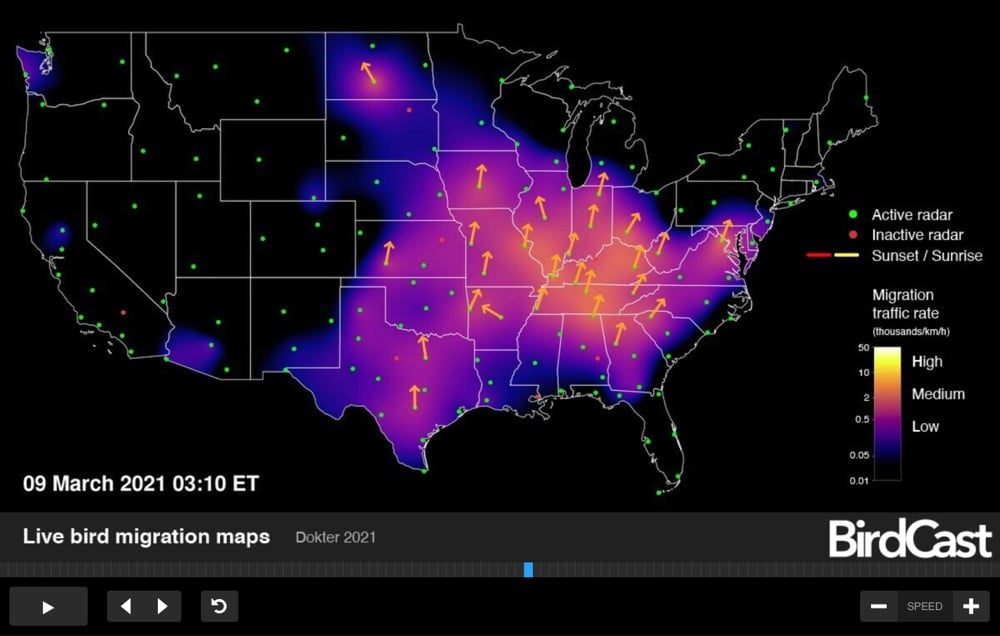
If the current & predicted bird radar maps were a part of the weather report on the local news, I might start watching again.
Plots of 80s movies if their protagonists had been people of color. “Ferris attends school that day, and every other day, until he graduates high school as valedictorian, goes to Yale, and becomes a dermatologist.”
A Drone’s Eye View of a Bowling Alley
The very first sequence of this video is of the camera — presumably perched on a drone — dropping out of the sky, flying through the door of beloved Minneapolis institution Bryant Lake Bowl, and following a bowling ball down the lane…and it just keeps going from there. Great drone piloting, choreography, sound design, and execution of concept. (via @brianmcc)
Update: ILM visual effects artist Todd Vaziri added Star Wars sound effects to the original video. He links to a few other remixes in this thread (like this Naked Gun one).
There Are Days, a poem by Kate Baer. “How they climb and climb and climb and climb.”
A Dutch Timber Skyscraper


Architecture firm Studio Marco Vermeulen has designed a 38-story building to be situated in Eindhoven, Netherlands that’s partially constructed from cross-laminated timber. They’re calling it The Dutch Mountains. From Dezeen:
Cross-laminated timber (CLT) sourced from sustainably managed forests will be used for much of the building, which will be largely prefabricated and assembled on site.
The publicly-accessible interior lounge and winter garden on the lower levels will be wholly constructed using timber, while heavy loaded structural elements, including lift cores and tower floors, will be made from concrete.
“Although not visible in every place, the wood gives a tactile quality to the interior,” Studio Marco Vermeulen said.
Looking at the pictures, it’s a head-trip seeing wood used so overtly & prominently in a building of this scale. We’re used to wooden houses but not wooden skyscrapers. I’m a fan of the vibe here: sustainable, more organic shapes & materials, big spaces that feel like they are, even in some small way, part of nature instead of deliberately apart from it. (via moss & fog)
The pandemic travel pause has given some communities a chance to rethink tourism. “Tourism had become extractive and hurtful, with tourists coming here and taking, taking, taking, taking, without any reciprocation with locals.”
What the End of the Pandemic Looks Like
Stat’s Andrew Joseph and Helen Branswell on the short-term, middle-term, and long-term future of the coronavirus in the US. The short-term outlook is dominated by vaccination & variants; some parts of the country will continue to be affected by outbreaks:
Conditions may be ripe for a better summer, however. Vaccine supplies should be flowing more freely, at least in the U.S.; the Biden administration now expects enough vaccine doses in hand for all adults by the end of May. With most vulnerable populations protected, there should be fewer hospitalizations and deaths. And with warmer weather, people can return to outdoor life.
Widespread transmission of the virus could be replaced by more sporadic and localized outbreaks. There’s also growing evidence that vaccines don’t just protect people from getting symptomatic Covid-19, but can reduce transmission.
And in the long-term, well, SARS-CoV-2 will be around for years and even decades to come:
Years from now, SARS-CoV-2 could join the ranks of OC43, 229E, NL63, and HKU1 — the four endemic, seasonal coronaviruses that cause a chunk of common colds every year. Essentially, our immune systems — primed by vaccines, boosters, and previous encounters with the coronavirus — will be ready to knock back SARS-2 when we see it again, potentially blocking an infection or leading to one that causes no symptoms or maybe just the sniffles.
It’s good to read stuff like this — it provides a basis to use when calibrating your optimism or pessimism for future activities and desires.
1-in-670 Americans has died of Covid-19 and 1-in-3 has lost someone they loved. This heart-wrenching interactive feature from the NY Times profiles some of those who have been lost and those left behind. Make some time for this.
Terry Boot takes over for Peter Foot at a shoe company. This is the best name-fits-the-job news since Doug Bowser became president of Nintendo of America.
The Earth Rising Over the Moon
Captured by the Kaguya lunar orbiter on April 5, 2008, this is an HD video of the Earth rising over the surface of the Moon. Watching stuff like this always puts me in a different frame of mind. (Turn off the sound if you don’t want to hear the super-cheesy narration.)
There’s No Real Reason to Eat 3 Meals a Day. “Your weird pandemic eating habits are probably fine.” In the past year, I’ve seen a big uptick in eating because I’m bored (and less healthily too).
The Kilobyte’s Gambit. Can you beat 1024 bytes of JavaScript in chess? (I love the disclaimer about not reporting en passant capturing as a bug.)
Van Gogh That Was in Private Hands for More Than a Century Up for Auction
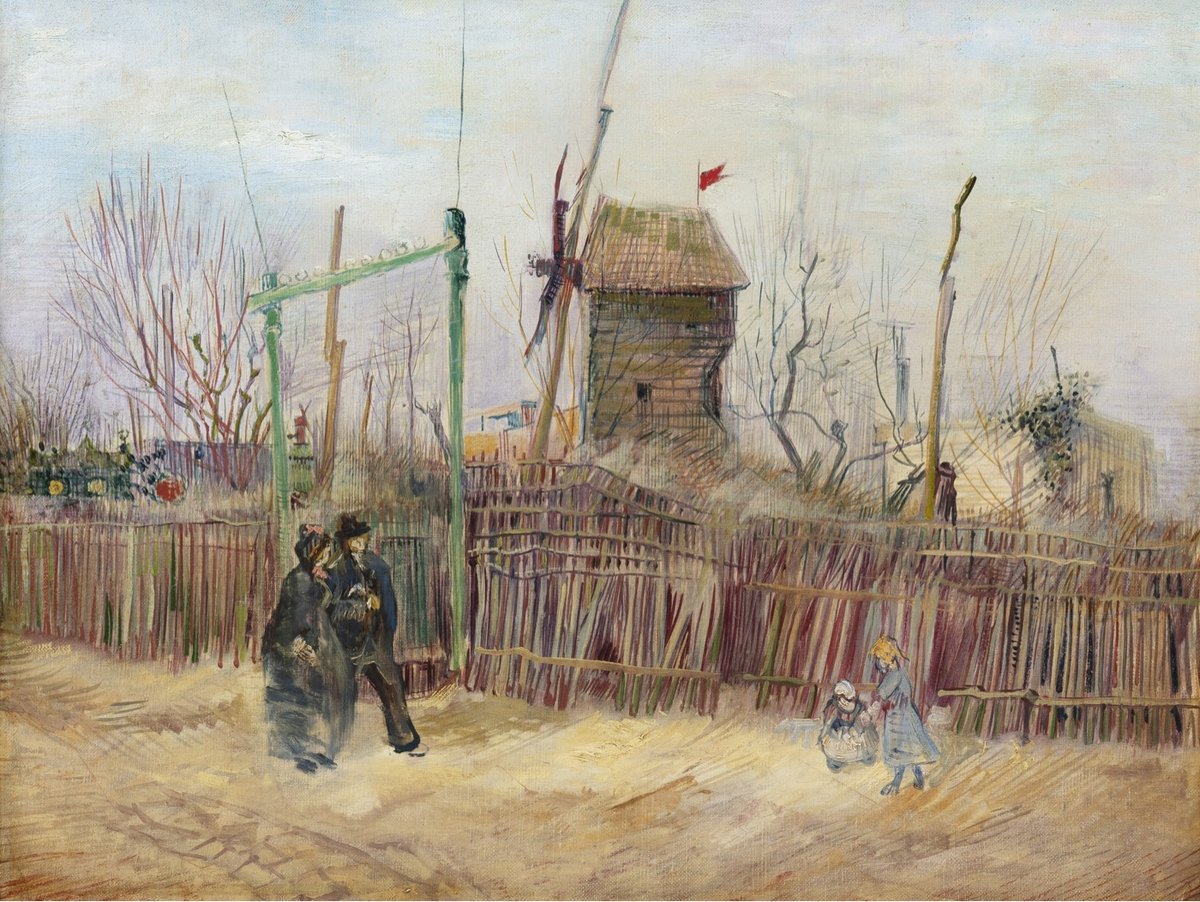
A painting by Vincent van Gogh that hasn’t been exhibited for the public since it was painted in 1887 is up for auction this month. The Paris landscape was created by the Dutch master on the cusp of his impressionist phase:
The work reflects Van Gogh’s exploration of a new city as well as his first encounter with the Impressionists and other avant-garde painters in Paris, which in turn sparked a transformation of his palette. “Gone were the dark tones of his early works, replaced with color in all its brilliance,” Sotheby’s writes in a statement. “It was in Montmartre, during these formative years, that the foundations of his inimitable style were established.”
There’s some press release sales bluster here, but looking at the painting, you can see inklings of his signature kinetic style — the flag appears to flutter, the trees wave in the wind, and the windmill spins. The whole thing is alive with motion. Wonderful. Here it is with the (assumed) original frame:

I hope that whoever buys it makes it available for public display; I’d love to see it someday.
Whoa, I heard this sonic boom created by a meteor last night. Didn’t see the fireball but the boom was so deep & loud that I legit started looking around for a mushroom cloud (80s kid habit).
R2-D2 and C-3PO Say “Get Vaccinated!”

In the 70s, the US government enlisted the droids of Star Wars to encourage parents to immunize their kids against childhood diseases like whooping cough and measles.
American parents weren’t getting their kids vaccinated. Measles, polio and whooping cough were taking a toll on young lives. Just as it is today, the message was important but the spot itself was horrible — a sludgy, if informative script. We shot it in a faux sci-fi control room. Most memorable was the way R2 appeared to pay no attention to the laws of physics.
(via kottke ride home)
The 50 Best Movie and TV Show Twists of All Time. Knives Out, Citizen Kane, Infinity War, The Good Place, Empire Strikes Back, and more.
America’s Vaccine Glut and “Vaccine Diplomacy”
After the Biden administration announced they will have enough Covid-19 vaccine supply to cover every single adult in the country by the end of May, I got to wondering about what they were going to do with the tens & hundreds of millions of surplus doses already procured for the remainder of the year. “Oh,” I thought, naively, “We’ll be able to distribute it to countries that can’t easily procure or manufacture vaccines of their own!” And I’m sure some of that will happen, if only for PR purposes. But it’s perhaps more likely that America will practice vaccine diplomacy and use the stockpile to reestablish its global leadership.
The United States has backed away from the world. This isn’t a Clinton thing or a W Bush thing or an Obama thing or a Trump thing or a Biden thing, but instead a United States thing. The American people lost interest in playing a constructive role in the world three decades ago, and America’s political leadership has molded itself around that fact. Trump may have been instinctually and publicly hostile to all things international, but Biden is only different in tone. Biden’s Buy-American program is actually more anti-globalization than Trump’s America-First rhetoric as it is an express violation of most of America’s international trade commitments. TeamBiden says it wants to reestablish America’s global leadership…but it plans to do so without any troops or money. Sorry, but that’s not how it works.
Which makes the possibilities for vaccine diplomacy wildly interesting. The United States has no responsibility to provide COVID vaccines to the world. It can — it will — distribute them, but it will want something in return.
Even if you disagree with some of the analysis here, it will be interesting to watch where America’s stockpile ends up. Given Biden’s rhetoric of “listening to the science” when it comes to the pandemic, I hope that at least some of that supply goes to places that need it most to make certain the pandemic doesn’t sputter on for years, generating potentially dangerous new variants, even if it’s politically disadvantageous.
Update: Countries now scrambling for COVID-19 vaccines may soon have surpluses to donate by Jon Cohen and Kai Kupferschmidt for Science magazine:
Like three dozen other countries, the United States contracted with multiple vaccine companies for several times the number of doses needed to cover its population. No one knew at the time which, if any, of the candidate vaccines would work or when they might prove safe and effective. But by now, most of the prepurchased vaccines appear to offer solid protection — which means many countries will receive far more vaccine than they need. The excess doses the United States alone may have by July would vaccinate at least 200 million people.
A chart in the article notes that the US has procured enough vaccine to cover almost 1.5 billion people after fully vaccinating its entire population.
A recent study found a correlation between places with Black Lives Matter protests and decreased killings by police. “Many cities with larger and more frequent BLM protests experienced greater declines in police homicides.”
Time Lapse of a Single Cell Growing Into a Salamander
In this six-minute time lapse video, you can watch a single cell grow into an alpine newt salamander. I got this via Craig Mod’s post about looking closely, in which he asks: when precisely does this collection of cells become a salamander?
The very definition of astonishing seems to be embedded in the way the cells move, as they grow from a “knowable” half-a-dozen dots to the millions and billions of the finished product. The phrase “sentience of the swarm” runs through my mind as I watch it. I am delighted and terrified: These little dots in aggregate know so much more than I ever will.
A new light installation by James Turrell is opening at MASS MoCA in May 2021. “I can make the sky any color you choose.”
Just sent out this week’s image-rich issue of the @kottke newsletter, featuring Wandavision cartoons (no spoilers!), letterlocking, and printed hair flowers.
“Why did Jack Dorsey buy Jay-Z’s failed music service?” Square bought a majority stake in TIDAL for some reason…
I have experienced absolutely no vaccine FOMO. It’s not my turn yet and mostly I just feel happy anytime people I know (or even folks I don’t) get their shot. Every jab gets us all closer to some normalcy.
Day Care Makes The World More Tender. “Silence the voice inside your head that has internalized the patriarchal belief that children are best loved at home, exclusively by their mothers.”
This Trained Singer Teaches Metal Bands How To Scream
Melissa Cross is a voice coach who works with metal bands so their screaming singers don’t damage their vocal cords. Her work involves switching singers from using their voice in an emotional way to a more classical and durable approach:
What metal singers do wrong is use an emotional response that feels like anger, or anxiety, in order to make the sound. And that involves too much tension. I use my acting training to imitate it, and my know-how vocally to do it in a way that could be healthy.
As someone whose throat starts hurting after 2 minutes of singing along to a favorite song, I’m fascinated by voice training. I don’t aspire to ever sing, but if I even want to do a podcast or some such, maybe I should hire a vocal coach? (via open culture)
Holy wow, this story by @choitotheworld. “All the pain of the past year taught me something: the true nature of intimacy.”
Johnson & Johnson announces trials to test their Covid-19 vaccine in children aged 12-17 and, following that, in younger children and infants. In an interview elsewhere, J&J’s CEO said those trials should be completed by Sept.
Create Escape — Bob Ross Narrates a Banksy Behind-the-Scenes Video
Banksy took some Bob Ross narration from The Joy of Painting and dubbed it over video footage that shows the street artist painting an image of an escaping inmate on the wall of a former prison in the dead of night. Colossal has more info on why Banksy picked the wall of this particular prison to do:
The expansive and unblemished prison wall was a daring and perfect spot for a Banksy piece. It’s best known for its most famous inmate: Oscar Wilde served two years in the prison from 1895-1897 for the charge of “gross indecency” for being gay. The work is clearly a tribute to the poet, as the escape mechanism appears to be a long strand of paper emerging from a typewriter in place of the usual bed sheets.
Colorful Floral Printing on Hair



After many years of experimentation, Spanish hairdresser Alexis Ferrer has developed a process for vibrant, full-color printing onto hair extensions, culminating in his recent collection, La Favorite (photographed by Rafael Andreu on model Emma Fuhrmann).1
Sidebar: why is it always so difficult to find out who the models are in fashion shoots like this? The articles and Instagram posts list the photographer, the stylist, the makeup artist, the assistant, and even the clothing brands but almost never the person actually being photographed (unless they are famous). Is Fuhrmann not an equal participant in the process of getting these photos just right? Seems retrograde.↩
Starlings Form Murmuration in the Shape of a Huge Bird
Photographer James Crombie and his friend Colin Hogg captured an amazing moment over Lough Ennell in County Westmeath, Ireland on Tuesday: a murmuration of starlings that, for a split second, looked like a huge bird. Crombie took the photo and Hogg the video:
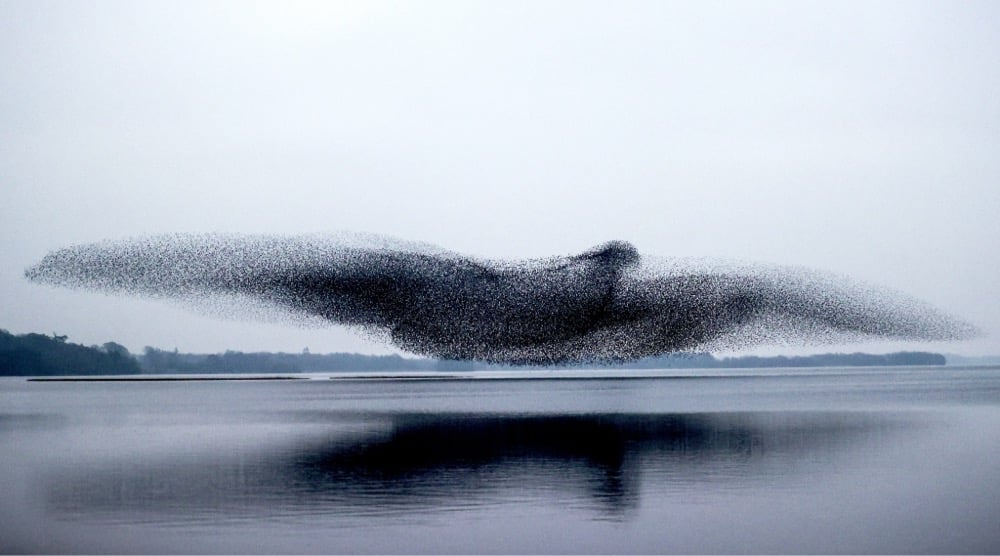
Crombie made, he thinks, about 50 trips to Lough Ennell in the past few months. “I’m usually a sports photographer, so for a while I’ve had a bit of time to think about other things. I had an image in my head,” he explains. “I could see they were making shapes. I kept going back, to get the image I had in my head.”
…
Finally, at about 6pm on Tuesday, Crombie focused his Canon EOS-1D X Mark III and got the image he wanted. That night alone he shot between 400 and 500 frames before capturing this unforgettable photograph. “It paid off,” he says.
I know there has to be a word for a collection of things that looks like an individual member of the group (like the school of fish in Finding Nemo) but I can’t find it right now. Anyone know? Or have a good suggestion? (thx, aaron)
It’s weird that a) NY will allow live performances to resume in April and b) this @nytimes piece about it doesn’t include a single quote from a scientist or public health official. Cases, positivity, deaths still at high levels in NYC.
Khoi Vinh and his 11-year-old daughter designed a family cookbook together. “It was a blast talking about these fairly esoteric topics…to have it come alive for her, demystifying the act of what it takes to create a ‘real’ book.”
Bob Odenkirk Action Movie??!
This is the trailer for Nobody, an action film that’s a cross between John Wick, Breaking Bad, and a tiny bit of Force Majeure (although maybe I’m alone in making this connection). The film stars Bob Odenkirk as an unassuming dad who decides he wants to be assuming again — violent hijinks ensue. Looks like it’s coming out in late March, which is still a bit too early for me to want to see a movie in a theater again.
Dolly Parton gets her first Covid-19 shot (she helped fund Moderna’s research) and sings a little song to the tune of Jolene. “Vaccine, vaccine, vaccine, vaccine, ‘cause once you’re dead, that’s a bit too late.”
The Gulf Stream, the Cold Blob, and a Potentially Frozen Europe
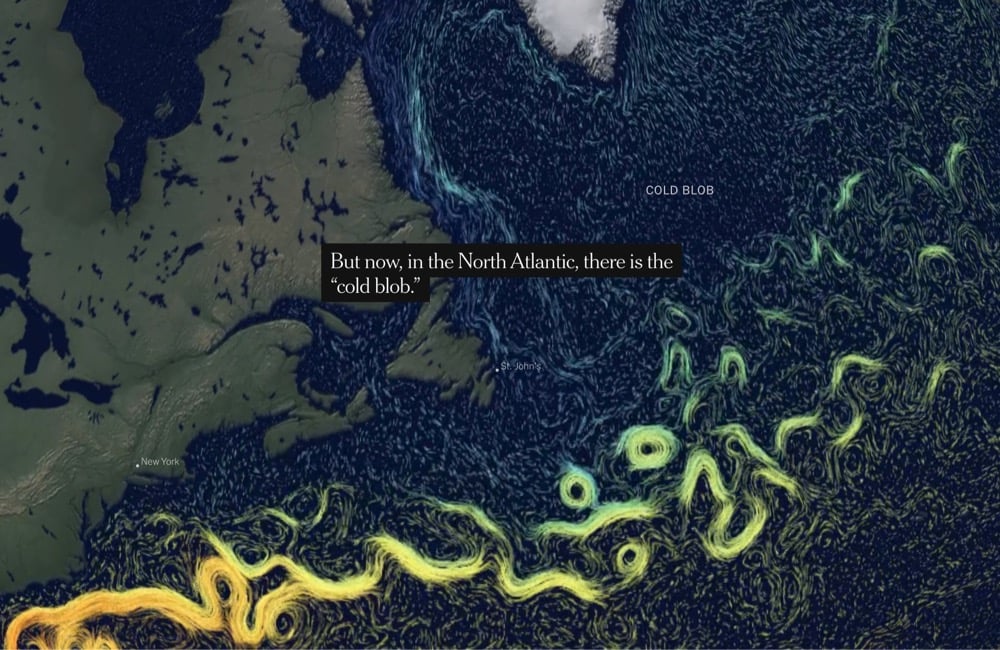
The NY Times has a fantastic interactive piece about a particularly disturbing aspect of the climate crisis: the evidence that a huge Atlantic circulation pattern is weakening and could collapse, leading to “a monstrous change” in temperature, precipitation, and other chaotic effects across the globe.
Now, a spate of studies, including one published last week, suggests this northern portion of the Gulf Stream and the deep ocean currents it’s connected to may be slowing. Pushing the bounds of oceanography, scientists have slung necklace-like sensor arrays across the Atlantic to better understand the complex network of currents that the Gulf Stream belongs to, not only at the surface, but hundreds of feet deep.
“We’re all wishing it’s not true,” Peter de Menocal, a paleoceanographer and president and director of the Woods Hole Oceanographic Institution, said of the changing ocean currents. “Because if that happens, it’s just a monstrous change.”
The consequences could include faster sea level rise along parts of the Eastern United States and parts of Europe, stronger hurricanes barreling into the Southeastern United States, and perhaps most ominously, reduced rainfall across the Sahel, a semi-arid swath of land running the width of Africa that is already a geopolitical tinderbox.
One of the potential reasons for this weakening is that the quickly melting Greenland ice sheet is dumping massive amounts of cold fresh water into the North Atlantic, disrupting the Gulf Stream. This is “the cold blob”.
The northern arm of the Gulf Stream is but one tentacle of a larger, ocean-spanning tangle of currents called the Atlantic Meridional Overturning Circulation, or AMOC. Scientists have strong evidence from ice and sediment cores that the AMOC has weakened and shut down before in the past 13,000 years. As a result, mean temperatures in parts of Europe may have rapidly dropped to about 15 degrees Celsius below today’s averages, ushering in arctic like conditions. Parts of northern Africa and northern South America became much drier. Rainfall may even have declined as far away as what is now China. And some of these changes may have occurred in a matter of decades, maybe less.
The AMOC is thus a poster child for the idea of climatic “tipping points” — of hard-to-predict thresholds in Earth’s climate system that, once crossed, have rapid, cascading effects far beyond the corner of the globe where they occur. “It’s a switch,” said Dr. de Menocal, and one that can be thrown quickly.
Which brings us to the cold blob. Almost everywhere around the world, average temperatures are rising — except southeast of Greenland where a large patch of the North Atlantic has become colder in recent years.
The title of this post references a “frozen Europe” but because the Earth is a nonlinear system, a weakened AMOC could actually have the opposite effect:
Scientists at the U.K.’s National Oceanography Centre have somewhat counterintuitively linked the cold blob in the North Atlantic with summer heat waves in Europe. In 2015 and 2018, the jet stream, a river of wind that moves from west to east over temperate latitudes in the northern hemisphere, made an unusual detour to the south around the cold blob. The wrinkle in atmospheric flow brought hotter-than-usual air into Europe, they contend, breaking temperature records.
“That was not predicted,” said Joel Hirschi, principal scientist at the centre and senior author of the research. It highlights how current seasonal forecasting models are unable to predict these warm summers. And it underscores the paradox that, far from ushering in a frigid future for, say, Paris, a cooler North Atlantic might actually make France’s summers more like Morocco’s.
(thx, meg)
Really happy to see that the Covid-19 vaccination effort is speeding up in Vietnam. In order to effectively end the pandemic (and guard against future dangerous variants), a fast, worldwide effort is necessary.
Digitally Reading 17th-Century Locked Letters
Using an x-ray technique, MIT researchers have digitally unfolded and read 17th-century letters that had been “letterlocked” by their authors to prevent them from being read in transit. Reading the letters in this way allows close study without actually unfolding and potentially damaging these letters or altering them against further study. This is a fully digital image of one of the unlocked letters:
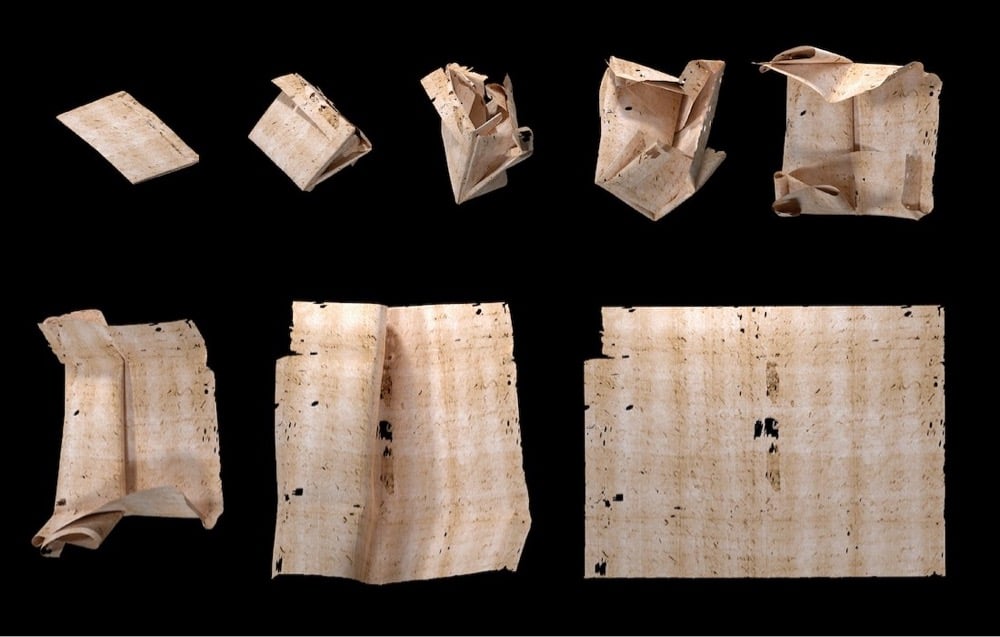
From a NY Times piece about the research:
In an interview, Jana Dambrogio, the study’s lead author and a conservator at the M.I.T. Libraries, said that learning of the trove’s existence inspired her to see if more technologically inclined colleagues could find a way to digitally open the locked letters. At the time, in 2014, scholars could read and study such letters only by cutting them open, which often damaged the documents and obscured or eliminated clues as to how they had been secured.
“We really need to keep the originals,” Ms. Dambrogio said. “You can keep learning from them, especially if you keep the locked packets closed.”
The old letters were protected from prying eyes when the sheets of writing paper were carefully folded to become their own secure enclosures.
The first step of their digital opening is to scan a target letter with an advanced X-ray machine. The resulting three-dimensional image — much like a medical scan — reveals the letter’s internal configuration. A computer then analyzes the image to undo the folds and, almost magically, turn the layers into a flat sheet, revealing handwritten text that can be read.
Here’s a contemporary example of the letterlocking technique where folds, slits, and wax are used to lock the letter and provide authentication:
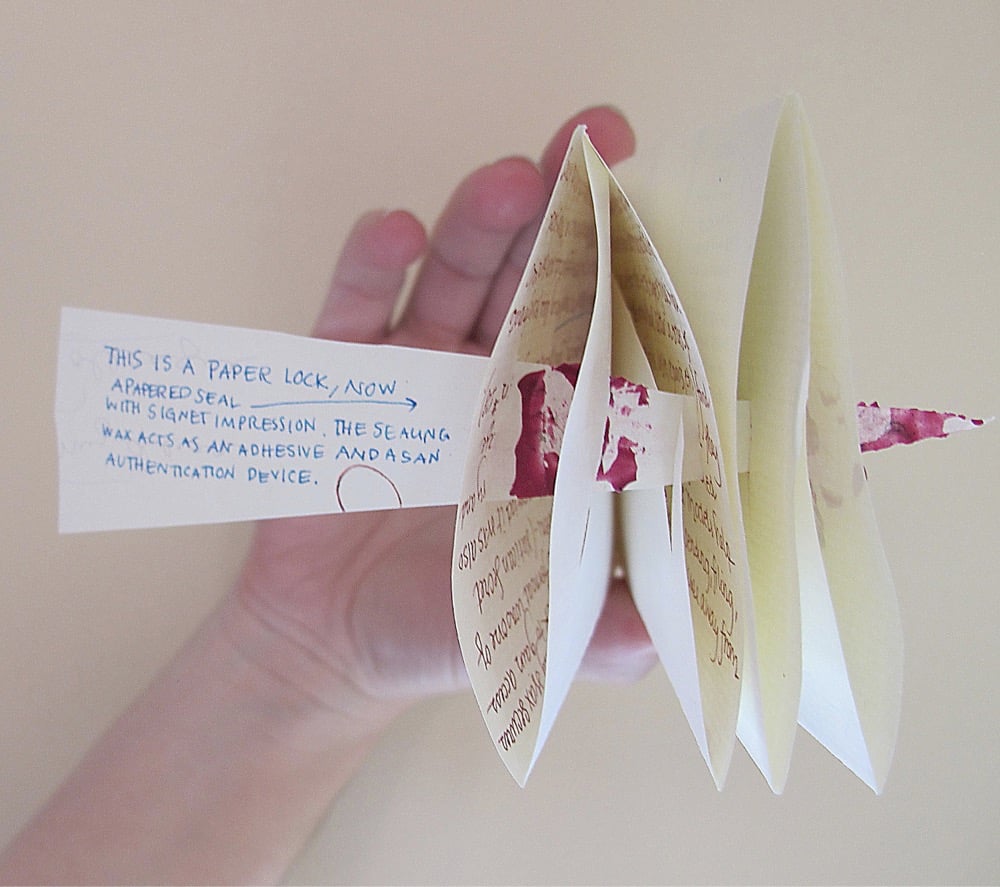
A letterlocking technique in action, modeled after a triangle-locked letter sent by Sir Francis Walsingham in 1587:
Whoa and this spiral-locked letter modeled on a message sent by Queen Elizabeth I to France’s Henry III in the 1570s:
And this is a list of all the letterlocking techniques and formats the researchers have identified:

You can explore more about letterlocking at Letterlocking.org.
Update: The group investigating letterlocking is back in the NY Times with updated research.
Topps Marks 70 Years of Baseball Cards with Special Artist-Designed Cards



In 1951, Topps released their first set of baseball cards, hoping to entice people into buying their chewing gum. Instead, they created a sports collectable industry that’s still going strong 70 years later. To celebrate the anniversary, “artists and creatives around the globe are revisiting and reimagining 70 years of iconic baseball card designs” as part of Project70.
They’re releasing a few cards at a time for a limited time — you can find the current selection in the Topps online store. I’ve included three of my favorites above: 1976 Mike Trout by Fucci, 1953 Rickey Henderson by Pose, and 1983 Roberto Clemente by Sean Wotherspoon.
Question: Since the case is now part of the collectable being sold, do you have to put the whole thing in a bigger case to preserve its overall mint condition? Where does this end? (via print)
Sculpture by Valérie Hadida

I love this bronze sculpture by French artist Valérie Hadida. You can find more of her work on Colossal and Artsy.
A Concerto Is a Conversation
In this lovely short film, composer and pianist Kris Bowers talks to his grandfather, Horace Bowers, about his life in the Jim Crow South and how he found a new life in California as part of the Great Migration. Horace’s move across the country set in motion events that culminated in Kris premiering a concerto he wrote with the LA Philharmonic. You can read more about Horace in this 2019 profile.
Yet, in a sign of the times, Horace encountered discrimination while building his business. At the time, mainstream financial institutions rarely gave loans to Blacks and Bank of America had already denied him. His fortunes changed after he hired a White young man as a presser.
“I gave him a job and after two days, he asked me to tell the bank that he had been working for me for 30 days. He said that he needed a loan because he had just gotten divorced and was broke and wanted to borrow money to go back to Texas,” said Horace.
“Even though I was with Bank of America, they had turned me down for a loan and I did not think he could get one. But, a few days later, his loan was approved. I wondered why, but I immediately thought of the color of my skin.”
Armed with this knowledge, Horace devised another route. He visited a different branch, picked up the loan papers, completed the forms and mailed them in.
“A few days later, my loan was approved and from then on, nobody saw us. I did mostly everything by mail,” he said.
What if Reese’s Peanut Butter Cups but without the chocolate? “Both the outer shell and inside of the cup are all peanut butter.” YES.
Why Does Vladimir Putin Want Alexei Navalny Dead?
After Vladimir Putin, dictatorial leader of Russia for over 20 years now, had seemingly insulated himself against losing power through control of the media, law, elections, and the wealthy allies, a lawyer named Alexei Navalny began to expose the corruption in Putin’s regime with a series of posts to his blog and on YouTube. Navalny continued his investigations, gaining public popularity and running for public office. Putin imprisoned him and tried to have him killed. This Vox video explains in more detail why Putin wants Navalny dead.
More reading on Navalny: Vox explainer, Masha Gessen on recent pro-Navalny protests in Russia. (via open culture)
What if the Earth were listed for sale on Zillow? “BEAUTIFUL, SUN-DRENCHED planet TRANSFORMED by human touch… The humans also redid all the floors in asphalt…”
Period-Specific Cartoon Homages to Wandavision
Art director Riana McKeith is watching Wandavision, each episode of which takes place in a different time period from the 50s to the present day. As a loving homage, she’s illustrating scenes from the show in the style of cartoons from each time period. Here’s the first episode, which takes place in the 50s a la I Love Lucy or Leave It to Beaver:
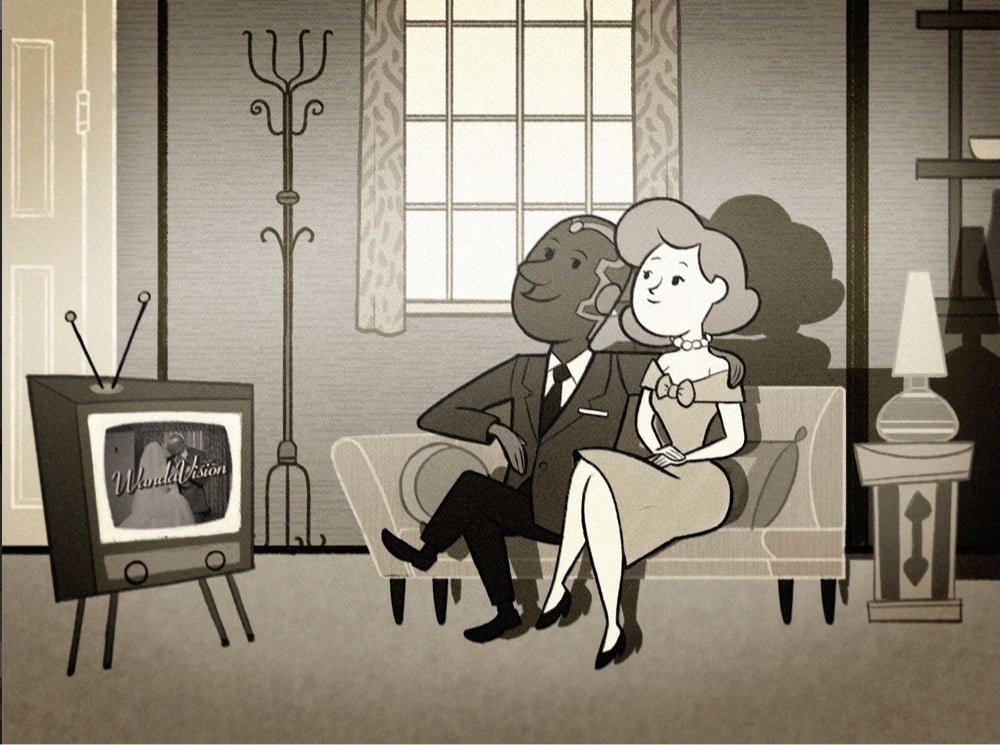
I don’t know enough about 50s cartoons to do more than guess at the inspiration of that one (Hanna Barbera? Looney Tunes?) but her 60s scene is obviously inspired by The Jetsons and The Flintstones:
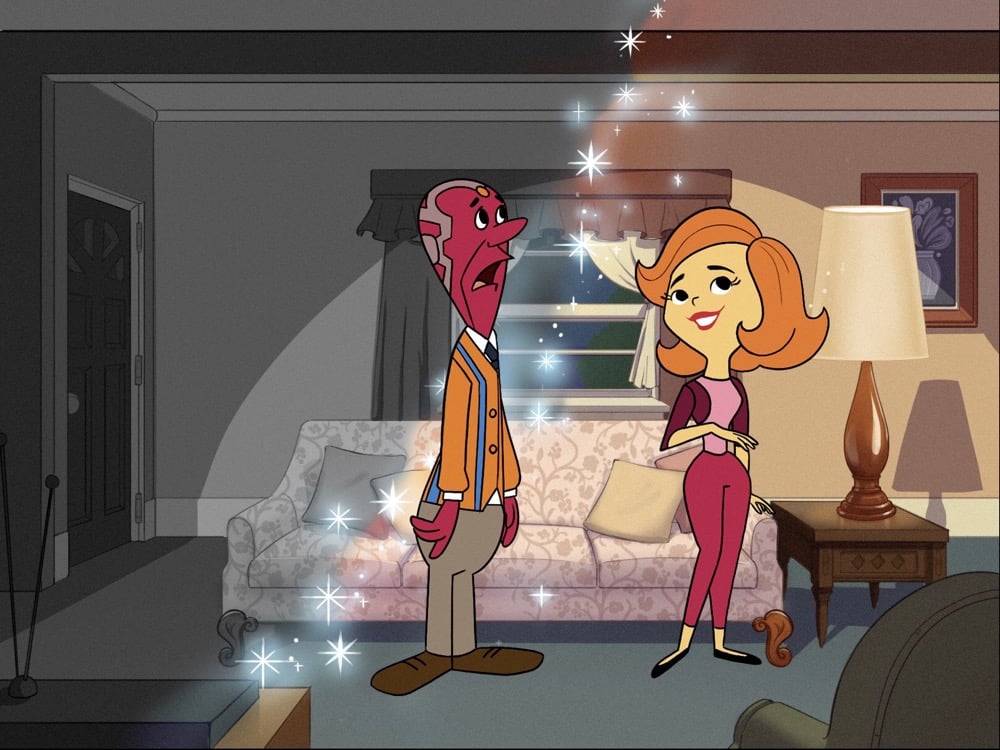
My kids and I are obsessed with Wandavision — it’s a big ol’ love letter to television — and this project is the perfect complement to the show.
Learning from the Five Pandemic Mistakes We Keep Making
Zeynep Tufekci has written an important piece for The Atlantic on the mistakes that the media, public health officials, and the public keep making during the pandemic and how we can learn from them. A big one for me is how scientists & other public health officials and agencies communicate their knowledge to the public and how the media interprets and amplifies those messages.
Thus, on January 14, 2020, the WHO stated that there was “no clear evidence of human-to-human transmission.” It should have said, “There is increasing likelihood that human-to-human transmission is taking place, but we haven’t yet proven this, because we have no access to Wuhan, China.” (Cases were already popping up around the world at that point.) Acting as if there was human-to-human transmission during the early weeks of the pandemic would have been wise and preventive.
Later that spring, WHO officials stated that there was “currently no evidence that people who have recovered from COVID-19 and have antibodies are protected from a second infection,” producing many articles laden with panic and despair. Instead, it should have said: “We expect the immune system to function against this virus, and to provide some immunity for some period of time, but it is still hard to know specifics because it is so early.”
Similarly, since the vaccines were announced, too many statements have emphasized that we don’t yet know if vaccines prevent transmission. Instead, public-health authorities should have said that we have many reasons to expect, and increasing amounts of data to suggest, that vaccines will blunt infectiousness, but that we’re waiting for additional data to be more precise about it. That’s been unfortunate, because while many, many things have gone wrong during this pandemic, the vaccines are one thing that has gone very, very right.
This pair of statements she highlights — “no clear evidence of human-to-human transmission” and “There is increasing likelihood that human-to-human transmission is taking place, but we haven’t yet proven this, because we have no access to Wuhan, China” — are both factually true but the second statement is so much more helpful, useful, and far less likely to be misinterpreted by people who aren’t scientists that making the first statement is almost negligent.
“An oily, 100-nanometer-wide bubble of genes has killed more than two million people and reshaped the world.” But are viruses alive?
Inside a Covid ICU, Through a Nurse’s Eyes
A film crew from the NY Times recently spent several days in the Covid-19 ICU in Arizona, at the time one of the hardest hit places in the world. Two of the nurses wore GoPro cameras while working to witness what they did on a daily basis — the 12-hour days, the grief, the care, the constant death. This video is incredible and incredibly difficult to watch — you actually see a patient die on camera, surrounded by nurses and family (virtually).
So many Americans have died in hospitals without family by their side, but they were not alone. Nurses brush patients’ teeth, change their catheters and hold their hands in their final moments.
At the beginning of the video, one of the nurses says, “Unless you’re actually in there, you have no idea.” Thanks to their willingness to share their experiences, now we at least have some idea.
Update: Vox talked to some ICU doctors about what it’s like for their patients when they die from Covid-19. Because of patient confidentiality and the contagious nature of the disease, society (and even the families) has been “protected and sheltered from seeing the worst of this disease”.
Imagine trying to breathe through a very narrow straw, says Jess Mandel, chief of pulmonary, critical care, and sleep medicine at UC San Diego Health. “You can do that for 15 to 20 seconds, but try doing it for two hours.” Or for days or weeks.
Patients struggling through low oxygen levels like this have told Kenneth Remy, an assistant professor of critical care medicine at Washington University School of Medicine in St. Louis, that it feels like a band across their chest or that their lungs are on fire. Or like a thousand bees stinging them inside their chest. Others might have thick secretions in their lungs that make it feel like they are trying to breathe through muck. Many people say it feels like they’re being smothered.
The ordeal is so taxing that many wish for death. “You hear the patients say, ‘I just want to die because this is so excruciating,’” Remy says. “That’s what this virus does.”
The COVID Zoom Boom Is Reshaping Sign Language. “Deaf people are adapting signs to accommodate the limitations of video communication while working from home.”
Spring Doorstop Musical Instrument. Booooiinnggg!
I didn’t realize it at the time, but making a spring doorstop keyboard was probably one of my greatest desires as a young child obsessed with those boingy door stoppers. We didn’t even have any of them in my house — playing with them was a rare treat when visiting friends’ and relatives’ houses. Thank you Ali Spagnola for fulfilling a childhood dream. (Can’t remember where I found this, but since it’s music-related it was probably via Ted Gioia.)
Update: See also the Quantum Garden, “an interactive art installation that demonstrates key concepts of quantum physics, such as quantum superposition, interference, and the Schrödinger equation.” (via @kayelcio)





Stay Connected